| |||||||
| Search Forums |
| Advanced Search |
| Go to Page... |
 |
| Search this Thread |  2,168,189 views |
| | #1 |
| Senior - BHPian Join Date: Apr 2018 Location: Bangalore
Posts: 1,565
Thanked: 17,813 Times
| Hyundai Creta : Official Review The Hyundai Creta is on sale in India at a price of between Rs. 9.99 - 17.20 lakhs. What you'll like: • A superbly engineered all-rounder that delivers a premium experience • We find the Hyundai Creta to be well-priced for what it offers • User-friendly interiors with sufficient space & good quality parts • Loved the 1.4L turbo-petrol & 1.5L diesel. These are fantastic engines • Smooth & competent automatic gearboxes available. With the useful "auto-hold" feature too • Sorted road manners & handling for a Hyundai, including on the highway. You will be surprised! • The Creta's safety package includes 6 airbags, ESP, all-wheel disc brakes, TPMS etc. • Impressive kit (panoramic sunroof, paddle shifters, Bose sound system, cooled seats, cabin air purifier & loads more) • Hyundai's competent after-sales service, fuss-free ownership & upto 5-years standard warranty What you won't: • Scored just 3-stars in the GNCAP crash tests • Oddball love it or hate it styling. We find the Creta's exterior design to be too weird & futuristic • Firmer suspension isn't as cushy as the 1st-gen Creta. It is more comfortable than the Seltos though • Back seat's width makes it better for 2 adults and a kid, rather than 3 adults • Some misses (no auto wipers, 360-degree camera, illuminated window buttons, full-size spare tyre on top trims) • Dual-clutch ATs (like the Hyundai Creta Petrol DCT) have a history of poor reliability in India • Diesel’s 113 BHP & 250 Nm – although adequate – are the lowest in the segment. Old 1.6L CRDi was superior • No manual transmission available with the fast 1.4L Petrol (Seltos offers this combo) • You get bigger SUVs & Crossovers for the same money (e.g. Hector, Harrier, XUV500) Last edited by GTO : 2nd January 2023 at 10:00. Reason: Updating with GNCAP score |
| |  (75)
Thanks (75)
Thanks
 |
| The following 75 BHPians Thank ChiragM for this useful post: | 7000plusrpm, abhinavinc, adwaith, akshay81, Amity, amit_purohit20, Arnav Vaghela, ashis89, ashking101, Bibendum90949, BIL2_HGi10, BlackPearl, BZ25, CARDEEP, CarguyNish, CEF_Beasts, chiefpk, Contrapunto, Cyborg, daretodream, dark.knight, Dr.AD, DriverNo.420, espraveen, Geo_Ipe, GTB, GTO, guyfrmblr, Hayek, HP-BHP, InControl, irajput, jailbird_fynix, lemedico, mh09ad5578, MMV, MSAneesh, N33raj, Nazaar25, noopster, PGNarain, pixantz, PrasunBannerjee, Punatic, RaghuVis, ramjiramu, RavenAvi, Redline6800, regenitin, Reinhard, Researcher, RJ2285, Roy.S, rqmar, S.MJet, Scorpion 10, searacer932, shipnil, Simhi, srikanthmadhava, SuhairZain, swiftnfurious, The Rationalist, theexperthand, Time_Machine, timuseravan, Tojo_GotBhp, vaasu, vattyboy, vb-saan, Venkatesh, Vik0728, vsrivatsa, VTec_KickedInYo, WhiteSierra |
| |
| | #2 |
| Senior - BHPian Join Date: Apr 2018 Location: Bangalore
Posts: 1,565
Thanked: 17,813 Times
| Review Index: Exterior Last edited by ChiragM : 17th September 2020 at 10:59. |
| |  (16)
Thanks (16)
Thanks
 |
| The following 16 BHPians Thank ChiragM for this useful post: | Amity, ashis89, BZ25, daretodream, deepakdograbhp, DriverNo.420, GTB, GTO, jailbird_fynix, RavenAvi, regenitin, Reinhard, Researcher, sahibrain, vb-saan, vredesbyrd |
| | #3 |
| Senior - BHPian Join Date: Apr 2018 Location: Bangalore
Posts: 1,565
Thanked: 17,813 Times
| Exterior 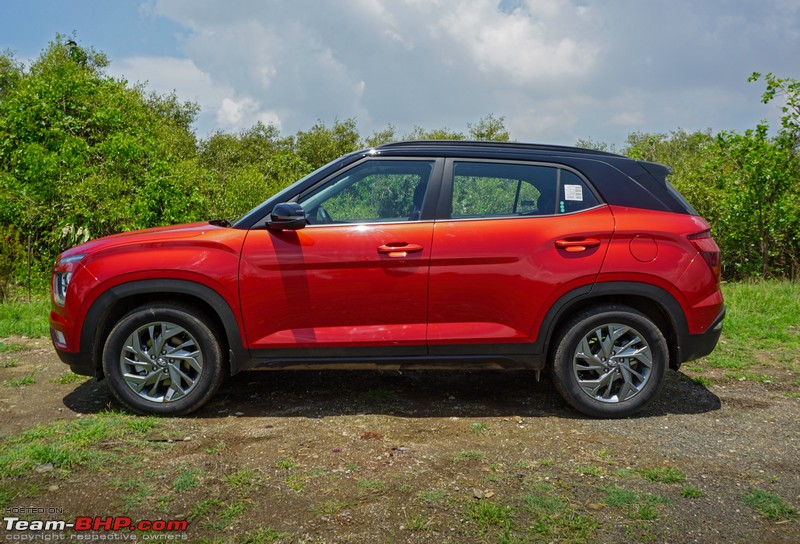 When it was launched in 2015, the Hyundai Creta stormed right into the lead of the urban SUV market in India. Its competition simply didn’t stand a chance as the Creta was a perfect combination of all the right ingredients. It boasted good quality, lovable styling, refined engines, multiple engine & gearbox options, balanced handling, being car-like to drive, loads of equipment and most importantly, it came with the trusted Hyundai badge. Sure it had a premium price tag, but the Creta managed to rule the Rs 10-20 lakh SUV segment for a long time. Come 2019, Tata launched the Harrier, MG introduced the Hector and Hyundai’s sister brand Kia entered the market with the Seltos. The competition had stiffened and it was time for Hyundai to respond by bringing in the second-generation Creta. Under the skin, the new Creta is the same vehicle as its biggest competitor and sister car, the Kia Seltos. They share the same platform which includes the powertrain options, type of suspension, and various structural and mechanical components. So what differentiates these two cars from different brands of the same company? It's the styling, features and tuning of some mechanical components. And what's important is that these differences are substantial enough to give each of these cars an individual identity. This is surely a more convincing approach than what we saw with the Volkswagen Vento and Skoda Rapid. Between the Hyundai Creta and the Kia Seltos, the Korean group will see 20,000 - 25,000 sales. We’ve never seen this kind of domination in a premium segment. Make no mistake though, while the parent group might be the same in Korea, it’s an absolute WAR between Hyundai India and Kia India. No love lost between these two. As we’ve seen on some of the recent Hyundais (and Kias), the Creta's build quality is pretty solid and it feels well-built. You'll also notice that the paint quality is excellent. What makes things even better are those tight and even panel gaps. The Creta uses a 74.3% advanced high-strength steel structure and has gotten heavier. It now weighs 1,282 kg, while the outgoing model weighed 1,250 kg.  Under the hood, the Creta comes with two petrol and one diesel engine options. You have a 1.5L naturally aspirated petrol, a 1.4-liter turbo-petrol and a 1.5L turbo-diesel unit. The 1.5L petrol and diesel motors come mated to a 6-speed manual gearbox. Automatic transmission options include an IVT (continuously variable transmission - CVT) for the 1.5L petrol, a 7-speed DCT (dual-clutch transmission) for the 1.4L turbo-petrol and a 6-speed torque converter for the 1.5L diesel. Interestingly, the 1.4L turbo-petrol along with a 6-speed MT that is offered on the Seltos has been given a miss on the Creta. However, like the Seltos, Hyundai has differentiated the enthusiast-focused 1.4L turbo-petrol variant from the 1.5L petrol and diesel engine variants by adding some sporty bits on the outside + inside of the Creta. Coming to safety, the Creta is equipped with dual front airbags, ABS + EBD, rear parking sensors and seatbelt reminder (for driver + front passenger) as standard. The SX and SX(O) variants get disc brakes all-round and ISOFIX child seat anchors. The top variant further gets 6 airbags, TPMS, ESP, hill-assist and vehicle stability management. Additionally, you get an auto-dimming IRVM with roadside assistance (RSA) and SOS buttons. As of date, the Creta has not been crash-tested by the Euro or Global NCAP (New Car Assessment Program). However, the Seltos - its sister car, has barely managed 3 stars in the GNCAP for the two-airbag version. Hyundai is offering a choice of 3 years / unlimited km, 4 years / 60,000 km or 5 years / 50,000 km as the standard warranty. That's unique and very welcome! Extended warranty up to 5 years / 1,40,000 km can be purchased additionally. We strongly recommend this extension if your usage is high. Hyundai is also offering 3 years of Road Side Assistance with the Creta, 3 years Blue Link subscription and a home visit on the 15th day of purchase. The polarizing front end is dominated by the cascade grille and split headlamp design. Although we still found the Creta ugly, many BHPians commented that it looks better in person and that it grows on you. Before you decide your viewpoint, we suggest catching it in person first. We also think that most people are getting used to the radical styling now. Still, looking “less ugly” in person is hardly a compliment. GTO hated it even 4 months after launch:  If you thought the front was polarizing, the rear is even more so! It has a very futuristic and concept-car vibe, which in some cases is a good thing, but not so much in the case of the Creta. Just like the headlamps, the tail-lamps get a split design too. There is a black insert connecting the two tail-lamp clusters that houses the HMSL. The skid plate is finished in matte black for the turbo-petrol variants. Other than the badging, there's no use of chrome anywhere else: 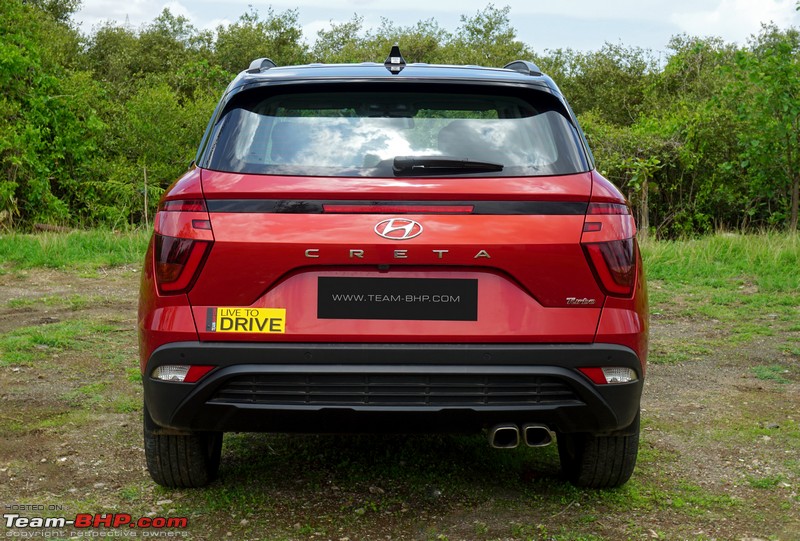 In the profile, you can see that the roofline slopes down towards the rear, giving it a squat stance. You have plastic cladding running across the running board and the wheel arches to give the car a crossover look: 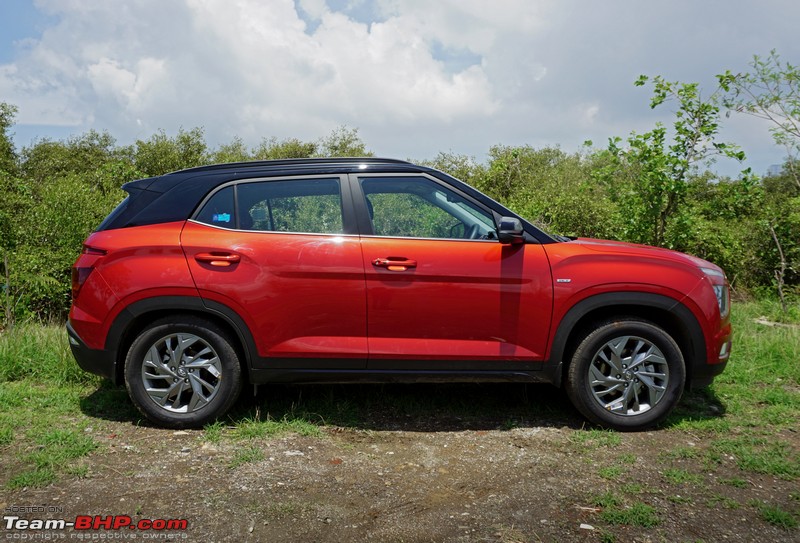 The Creta measures 4,300 mm in length and 1,790 mm in width, and 1,635 mm in height. At 2,610 mm, the Creta’s wheelbase is identical to the Kia Seltos. While both these cars are practically the same size, the Seltos is a few millimetres longer, wider and taller than the Creta: 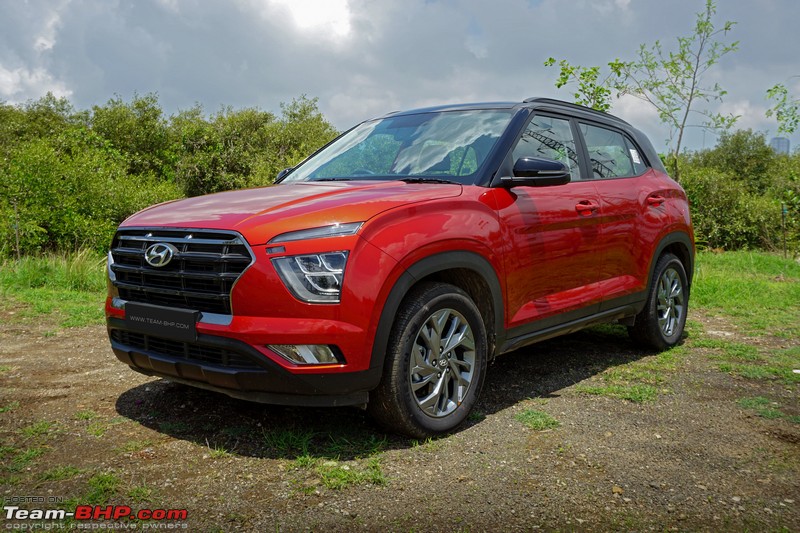 Sharp creases give the Creta a muscular look. The dual-tone exterior colour scheme is offered only on the turbo-petrol. If you really love the car but hate the styling, might we suggest a darker colour? Check out BHPian Turbokick's black Creta here or the forest green (that's what Hyundai calls it) colour shot by Overdrive magazine here. Surely looks more palatable in these shades: 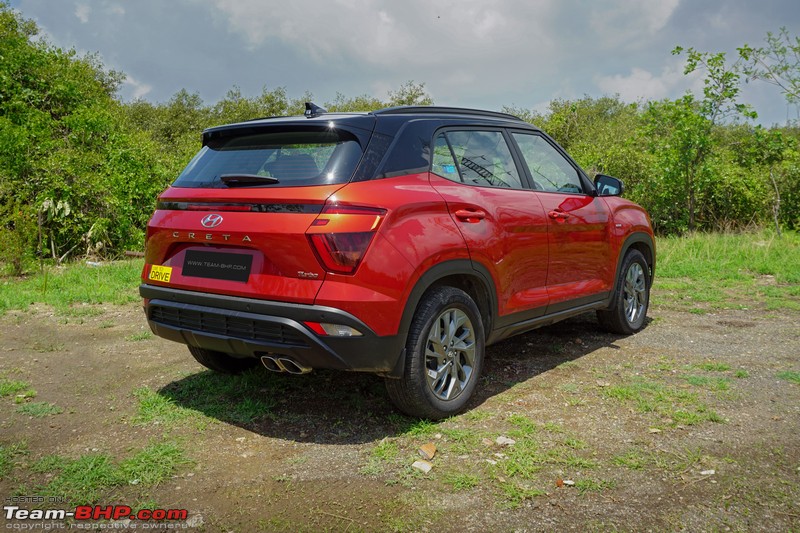 The entire headlamp cluster is a single unit with just a plastic insert in between which gives it the appearance of a split design. Now if you think about it, that’s a big unit - it’s almost as tall as the grille! While most manufacturers go for a sleek design for the headlamps, this in your face design approach is quite unique. The SX and SX(O) variants get LED headlamps and DRLs: 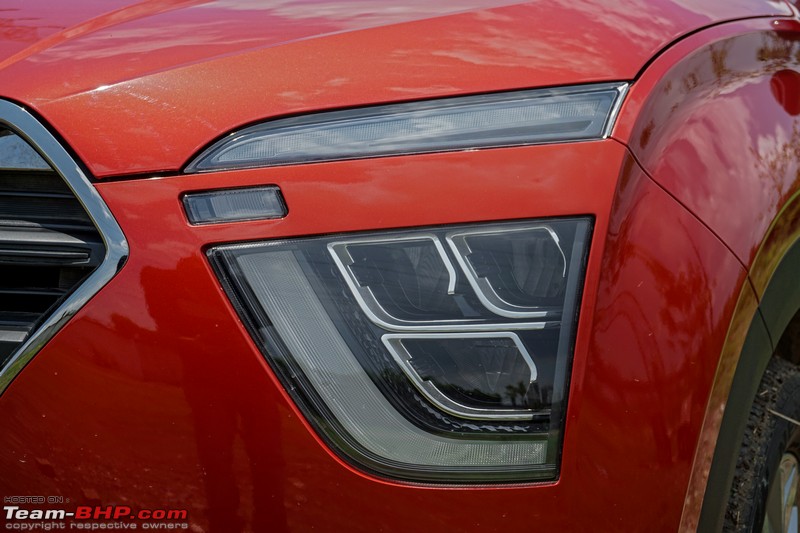 Check out this hexagonal detailing and chrome inserts in the headlamp cluster: 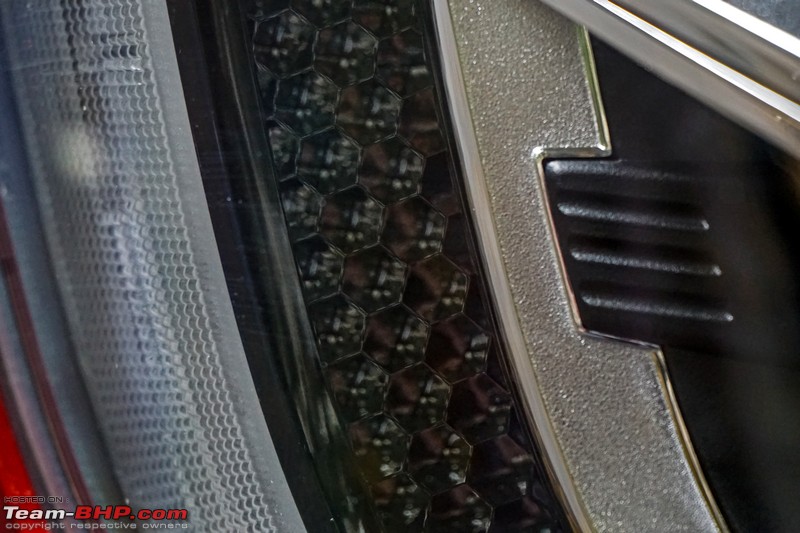 A look at the headlamp cluster with all the lights in action. Headlights have a follow-me-home function: 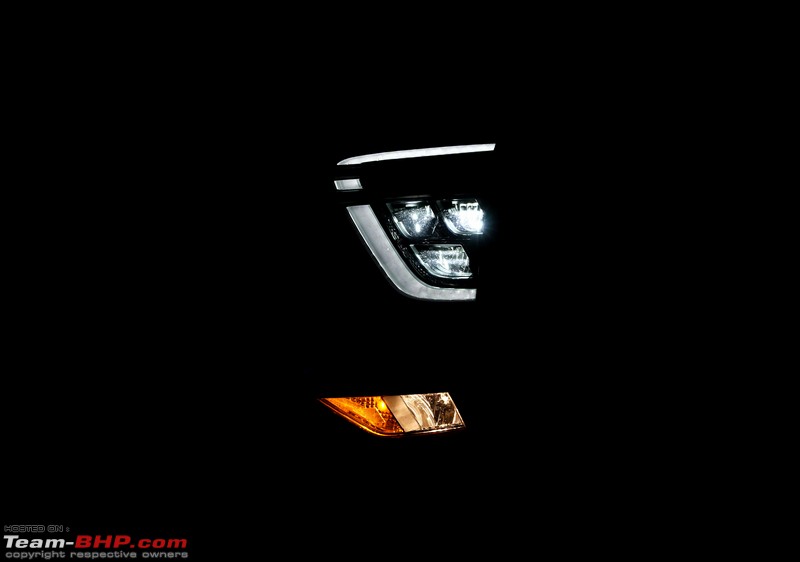 DRLs are bright and prominent, even during the day:  The grille gets a thick chrome border and has four horizontal slats with the topmost one finished in chrome: 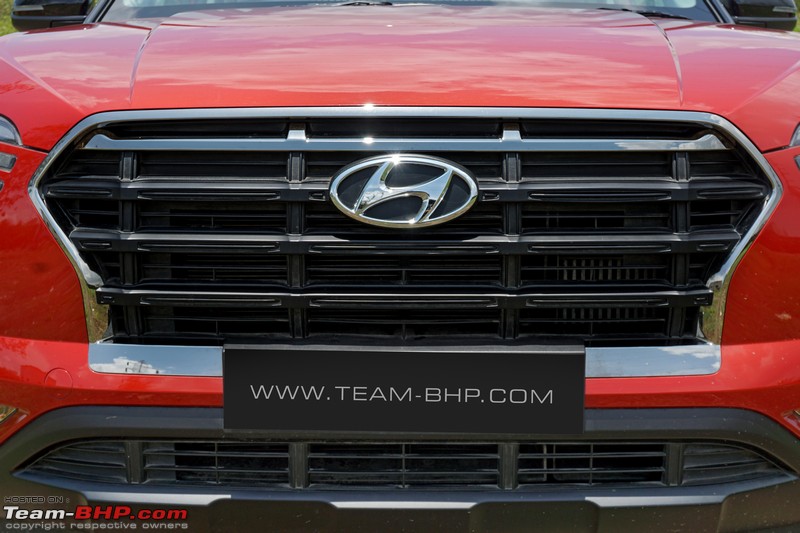 Variants other than the turbo-petrol DCT get these grey inserts instead of the black: 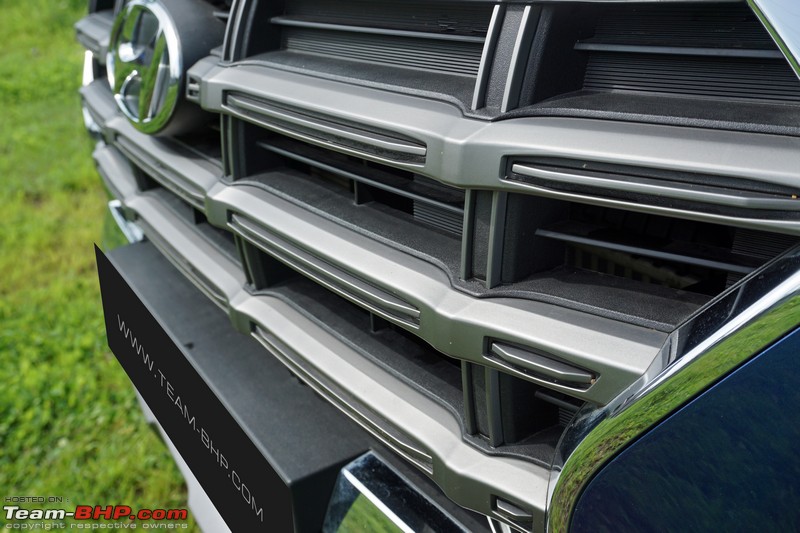 The front bumper houses a wide air dam, fog lamps and turn indicators. At the bottom you have a faux skid plate along with a wind deflector:  A look at the faux silver skid plate on the 1.5-liter petrol & diesel cars:  The front turn indicators are placed too low. This can be dangerous as they might not always be visible in the IRVM of the car ahead of you. No LED foglamps like the Seltos. These are plain halogen units: 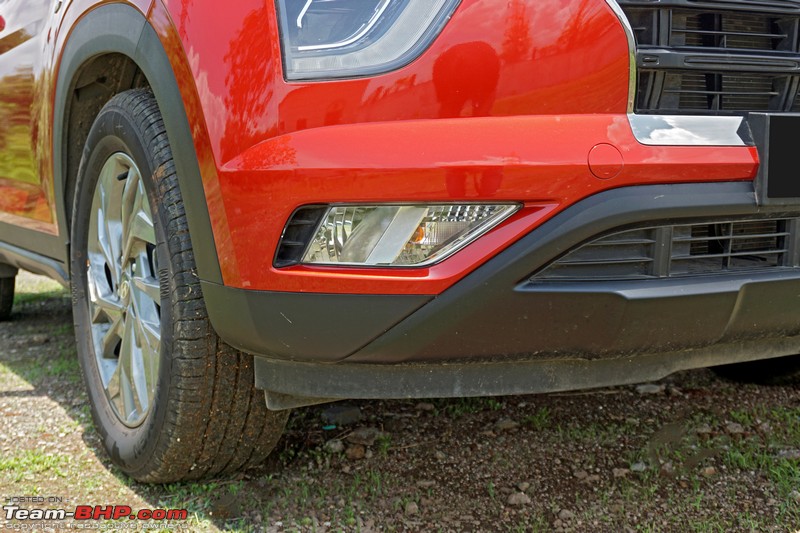 Small bits to improve aerodynamic efficiency. Wheel air curtains (vents) next to the fog lamps direct air to the front wheels. This helps reduce drag and fuel consumption: 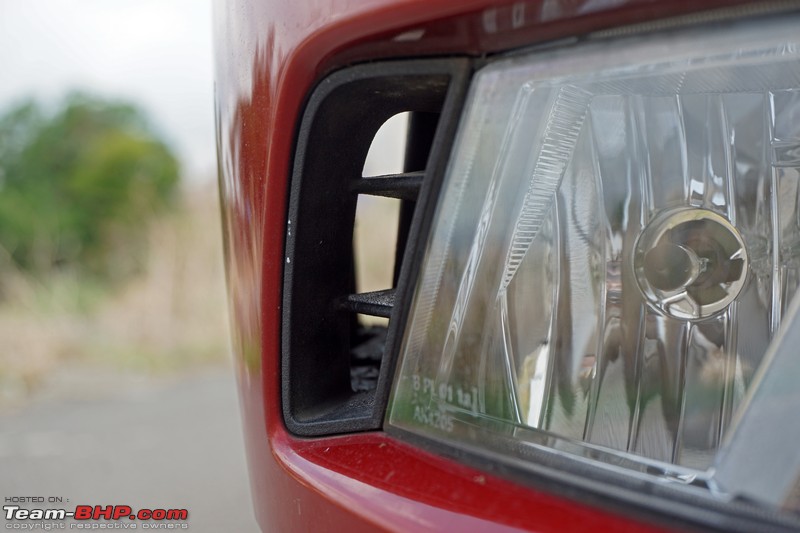 Tow-hook cap has an arrow indicating where you should press to remove it: 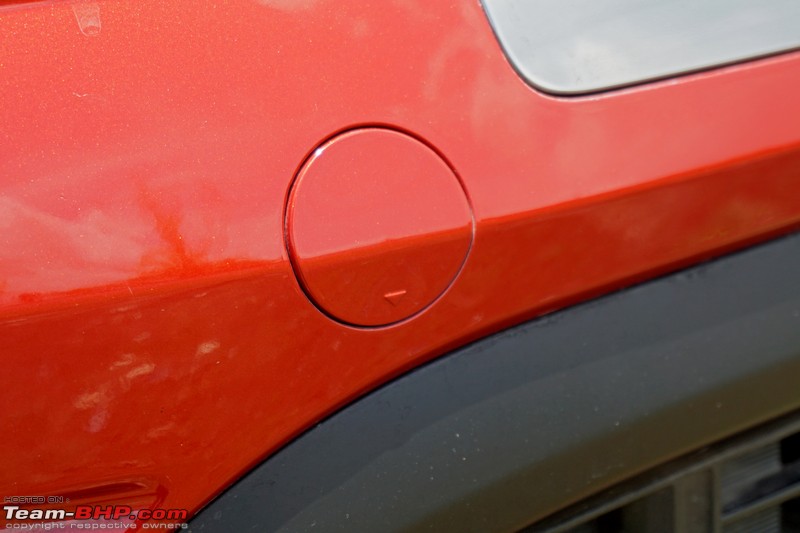 There is a good deal of underbody protection. This is important for India's unpredictable road conditions:  Bonnet features a wide and largely flat central dome, while four prominent creases give it some muscle. Notice how the creases on the sides merge with the top slat on the grille:  Wiper spindles are concealed under the bonnet...  ...as are the windshield washers: 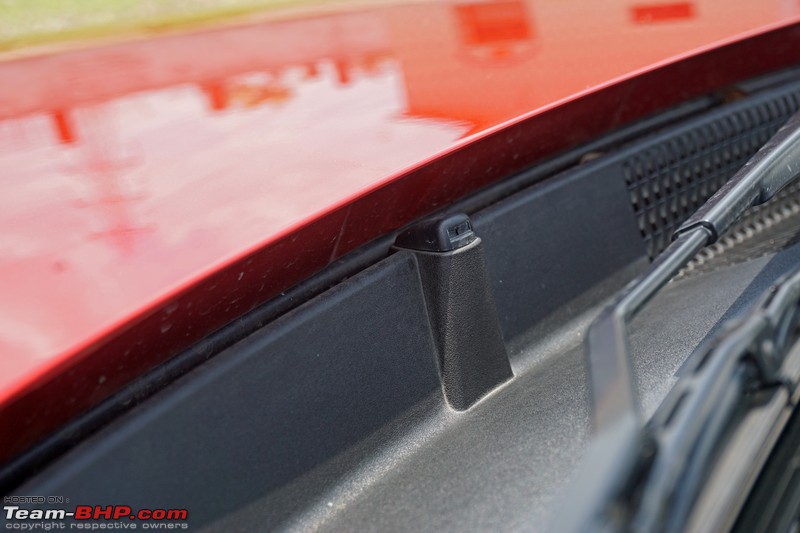 Both windshield washers squirt out effective sprays (rather than jets) of water: 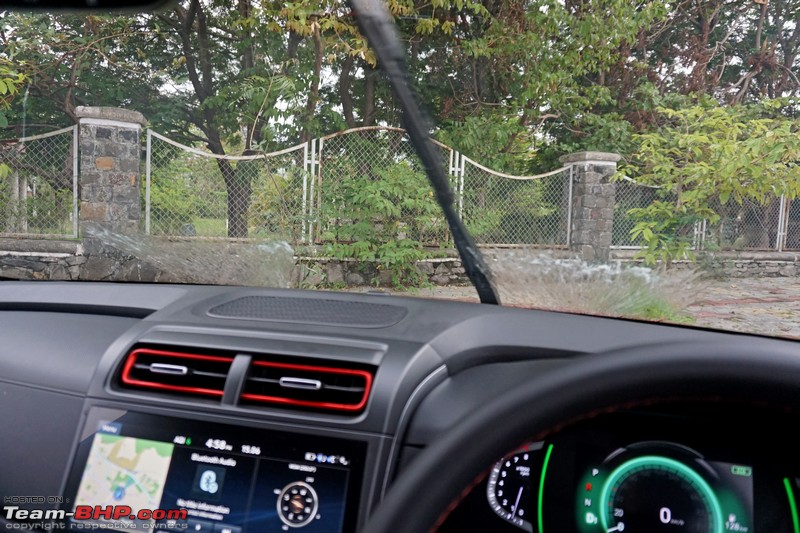 Dual-tone body colour + black ORVMs (other variants get body colour) with integrated LED turn indicators. They are electrically adjustable + foldable, and also have an auto-folding function on lock / unlock: 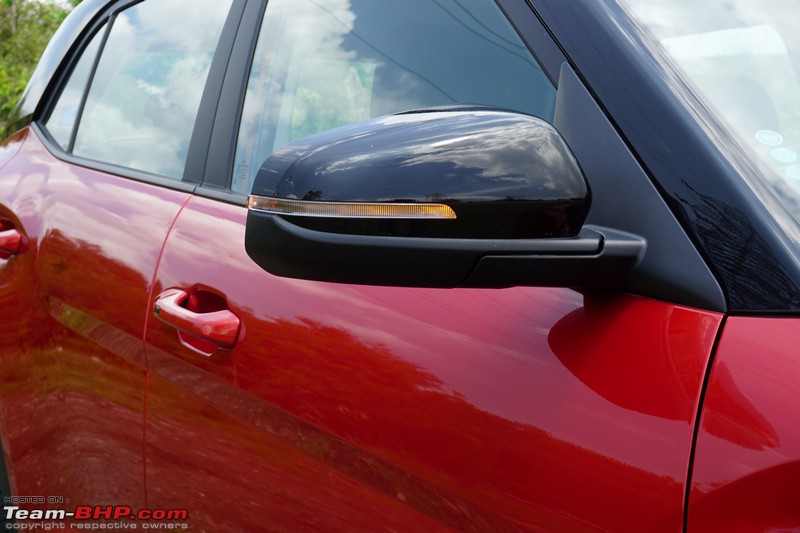 SX and SX(O) variants get puddle lamps underneath the ORVMs. The Creta doesn’t get a 360-degree camera like the Seltos, which has a camera in this spot (reference image):  Body-coloured door handles get a request sensor on the driver's door. There is no request sensor or keyhole on the front passenger side door: 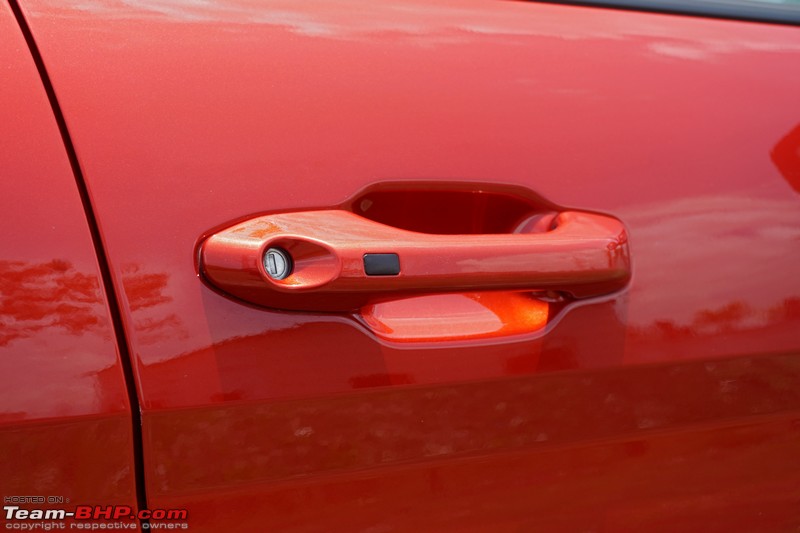 SX and SX(O) variants of the 1.5L petrol and diesel get chrome door handles:  Roof slopes down towards the rear while the window line rises. The absence of chrome in the side profile looks good:  Hyundai calls this silver insert ‘Lightning Arch C-Pillar’ and it looks terrible here. It is painted gloss black in the dual-tone variants as seen in the previous picture: 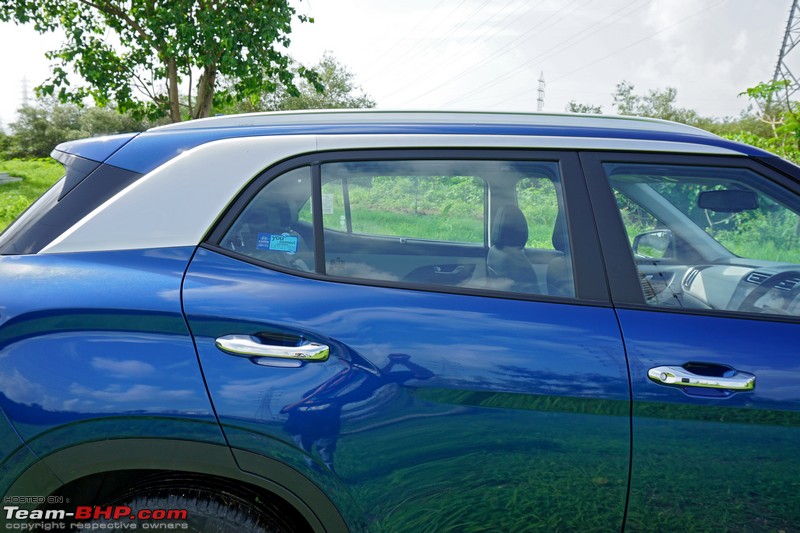 There's a prominent haunch that originates on the rear door, runs across the rear panel and merges with the tail-lamp:  Two character lines run across the doors. The previous generation Creta had a much more prominent side character line (reference image): 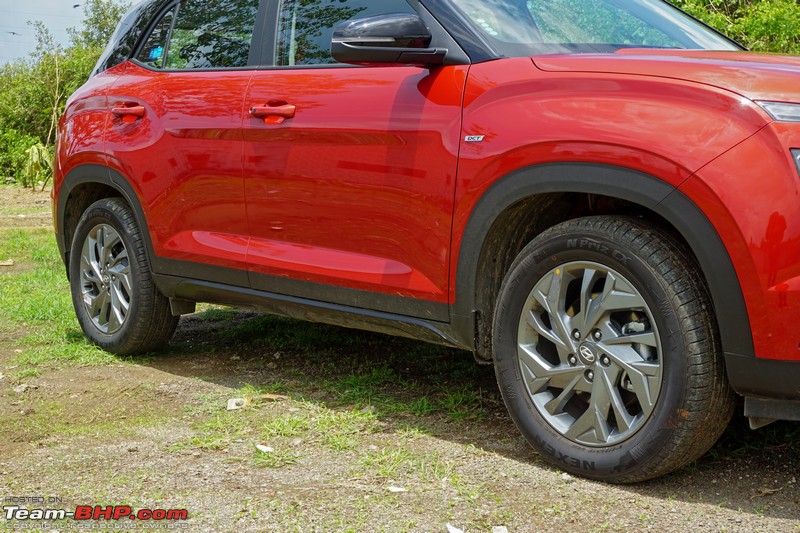 Silver coloured side skid plates on the non-turbo-petrol cars: 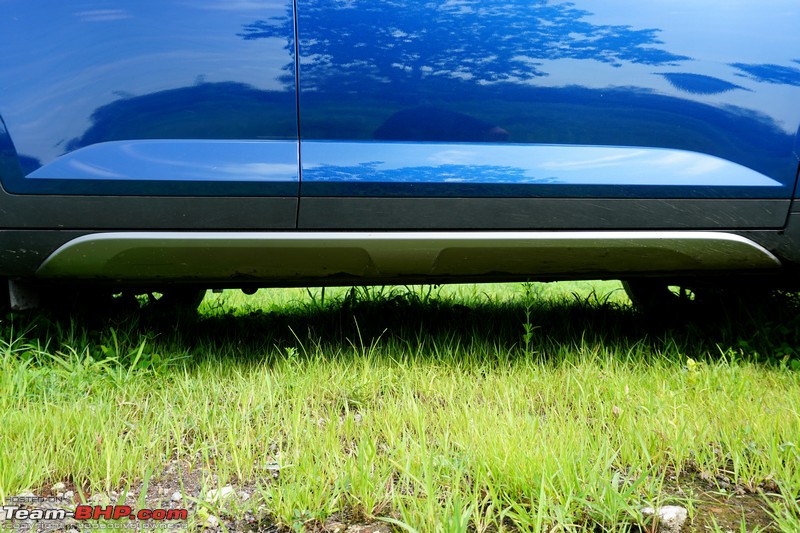 Rear bumper barely sticks out, which means that the tailgate would get easily damaged in case of a rear collision: 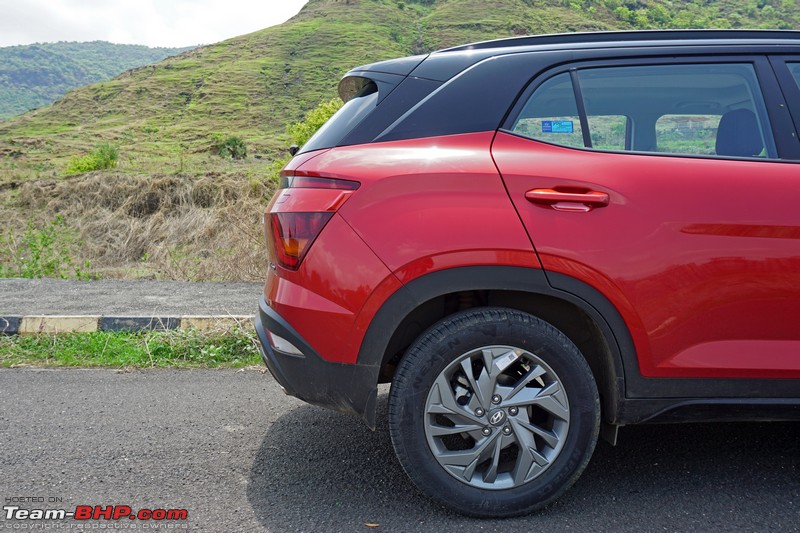 The turbo-petrol variants get 17-inch single-tone grey alloy wheels shod with 215/60 section tyres. I personally don’t like the design at all: 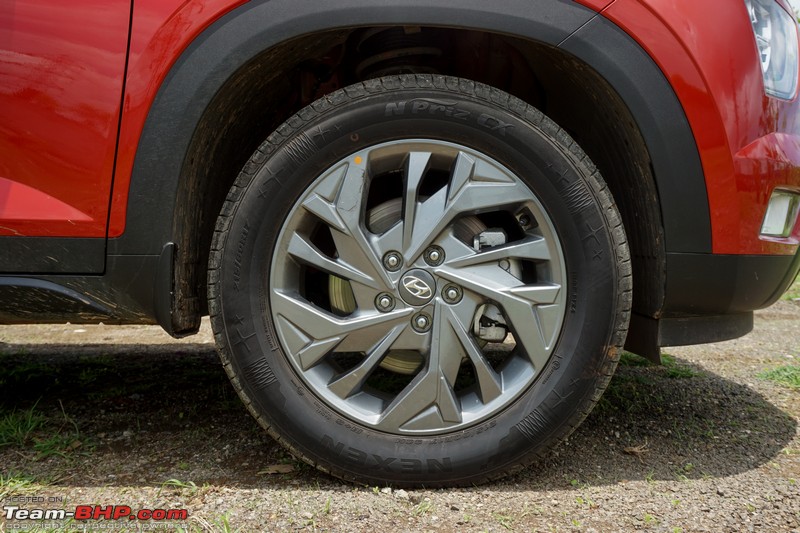 The diamond-cut alloys that you get with the 1.5L petrol and diesel SX(O) variants. E, EX and the S variants get 16-inch wheels with 205/65 section tyres:  Small mud-flaps located ahead of the rear tyres: 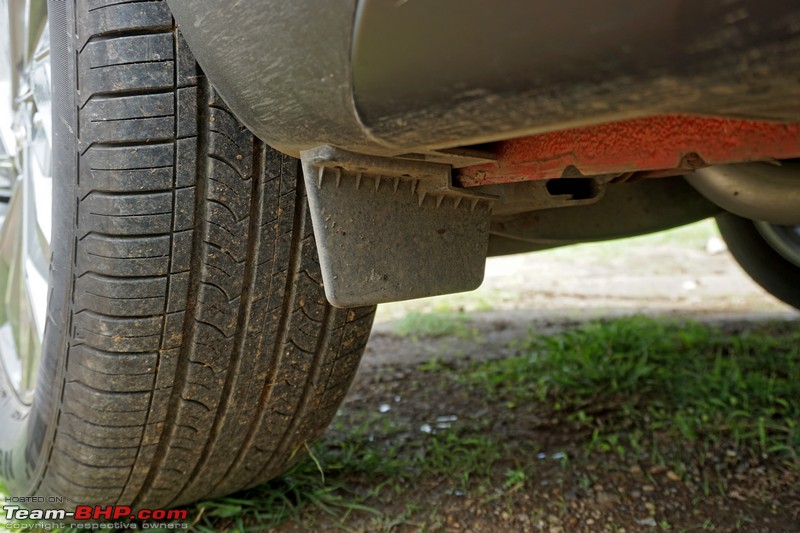 All-wheel disc brakes are only offered on top-end SX and SX(O):  Flush-sitting roof rails are finished in matte black in the turbo-petrol cars: 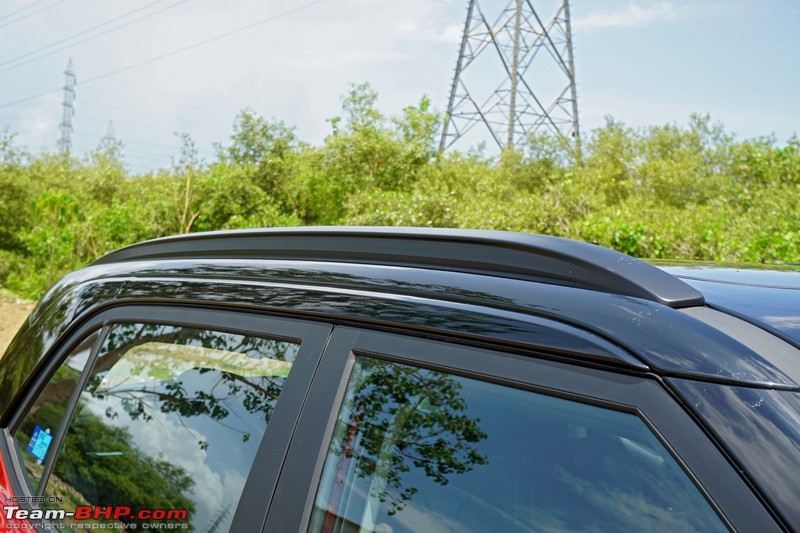 A look at the silver roof rails on the other variants: 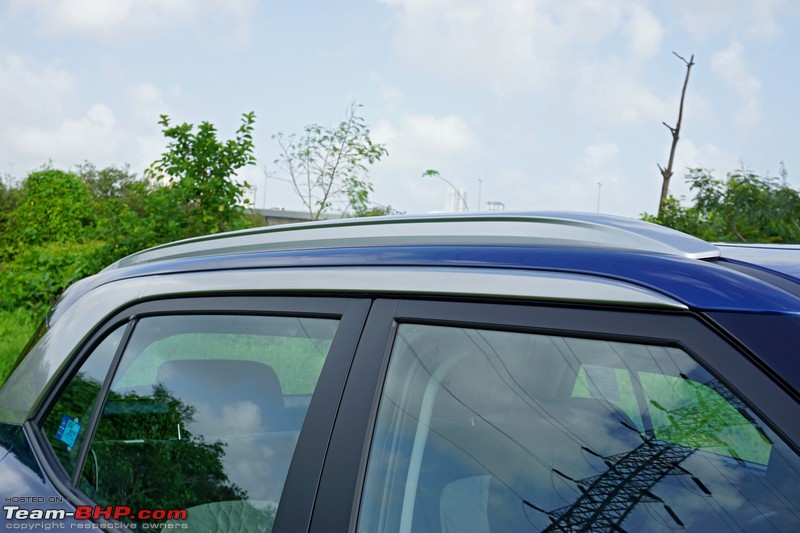 SX and SX(O) variants get a panoramic sunroof. This is one of the biggest-selling points for the Creta over the Seltos: 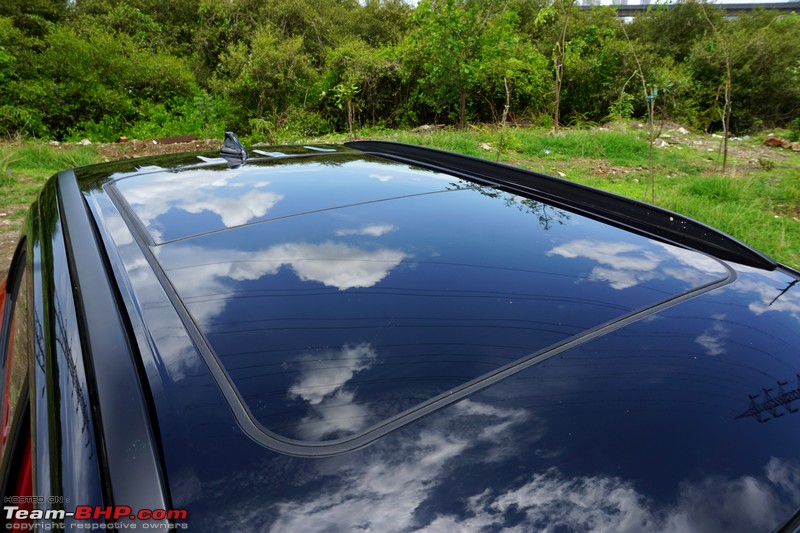 All variants except for the base E variant get a sharkfin antenna: 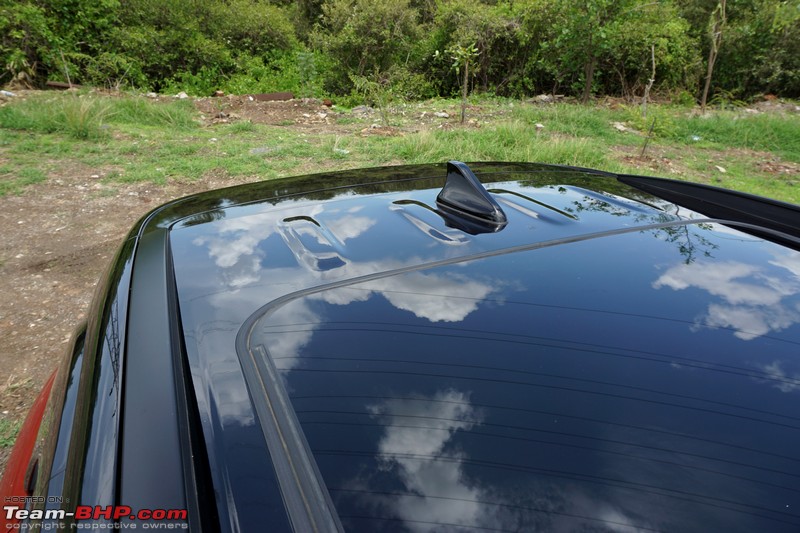 Tailgate gets a subtle and neatly integrated spoiler: 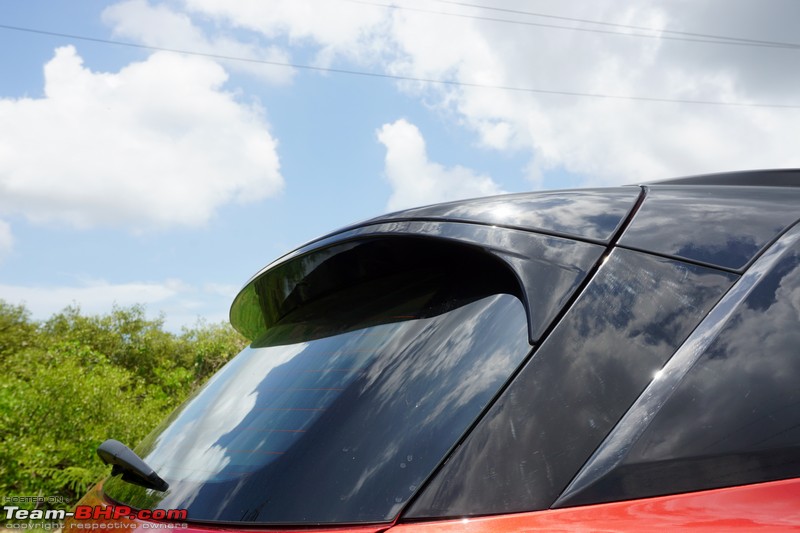 Windshield washer is well-integrated in the spoiler:  Just like the headlights, the Creta gets split tail-lamp clusters. The insert placed on the tail light is made out of plastic and hence you can see a minor colour difference (which will most likely get more noticeable with age). The S, SX and SX(O) variants get LED tail-lamps:  A close look at the hexagonal design pattern in the tail-lamps: 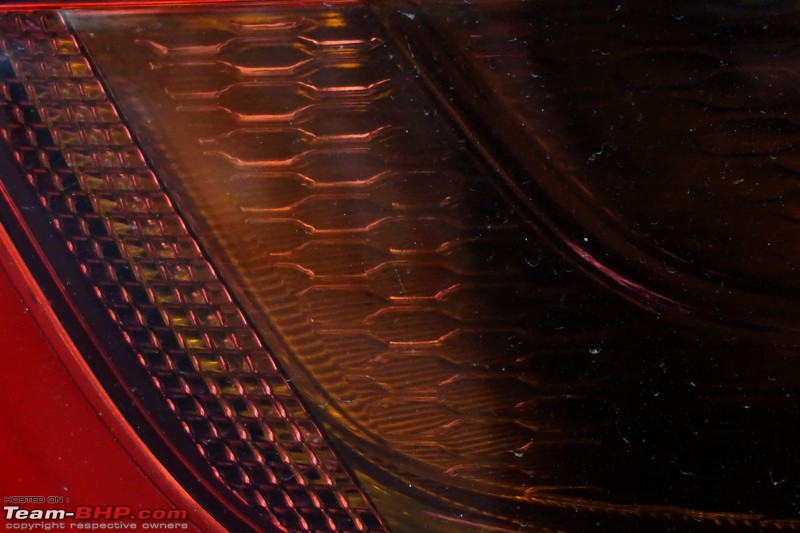 Tail-lamps get this aero fin on the plastic insert: 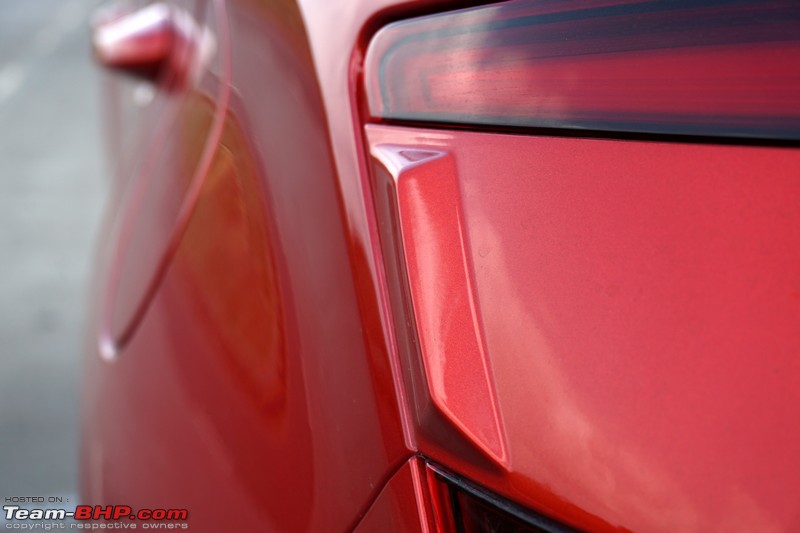 A look at the tail-lamp cluster with all the lights and the reversing light at the bottom in action: 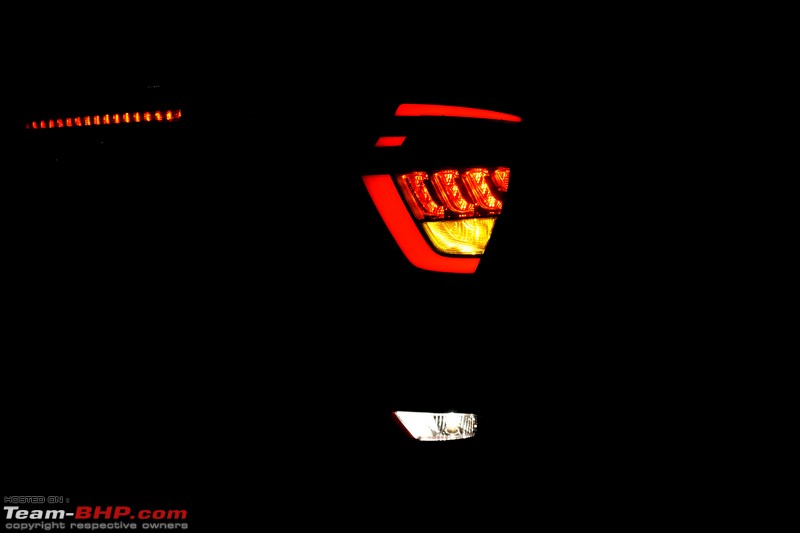 The tailgate has a glossy black insert running across its width connecting the upper parts of the split tail-lamps. Below this, you get bold 'CRETA' chrome lettering which looks like an aftermarket addition. Other than the badging, there's no use of chrome anywhere:  Weird positioning of the HMSL - it's not high mounted! A spoiler integrated HMSL (which is a norm these days) would’ve been much preferred: 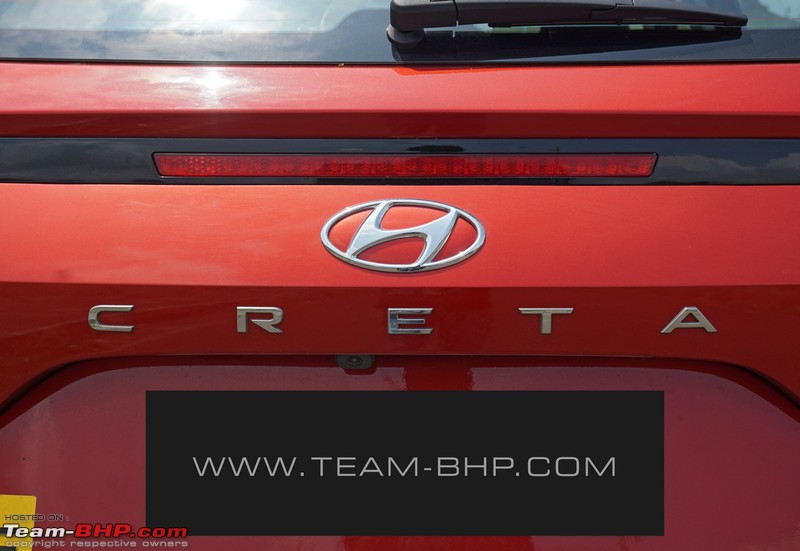 Reversing camera is tucked away under the CRETA lettering, with the electromagnetic boot release next to it: 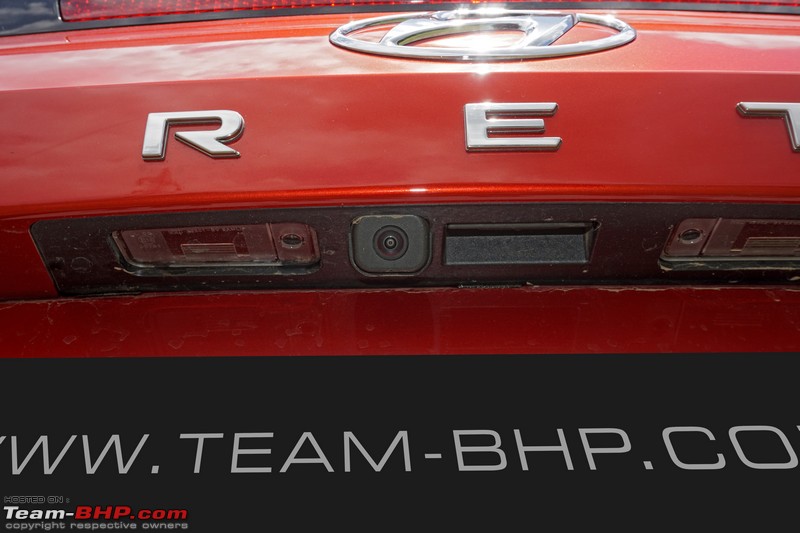 A look at the variant badging on the diesel variant:  The rear bumper houses reversing lights and reflectors on either side. You also get 4 parking sensors and a faux skid plate finished in matte black which has a cutout for... 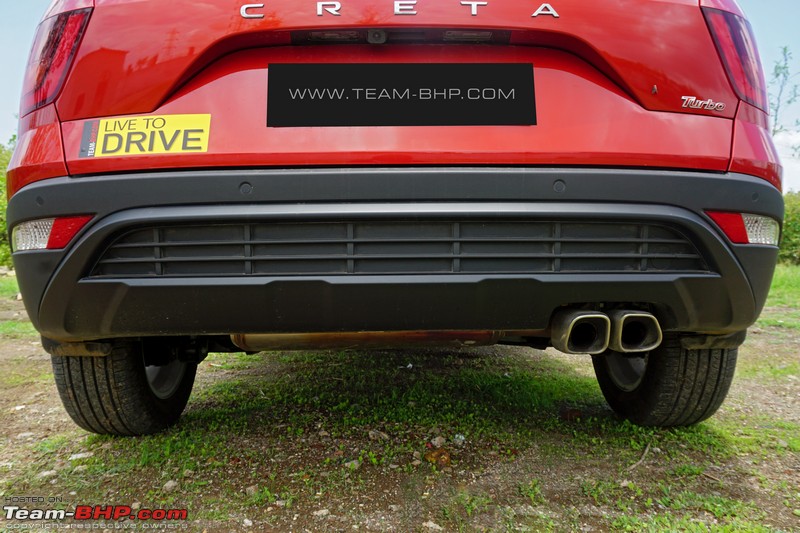 ... these sporty-looking twin chrome exhaust tips. These are exclusive to turbo-petrol variants: 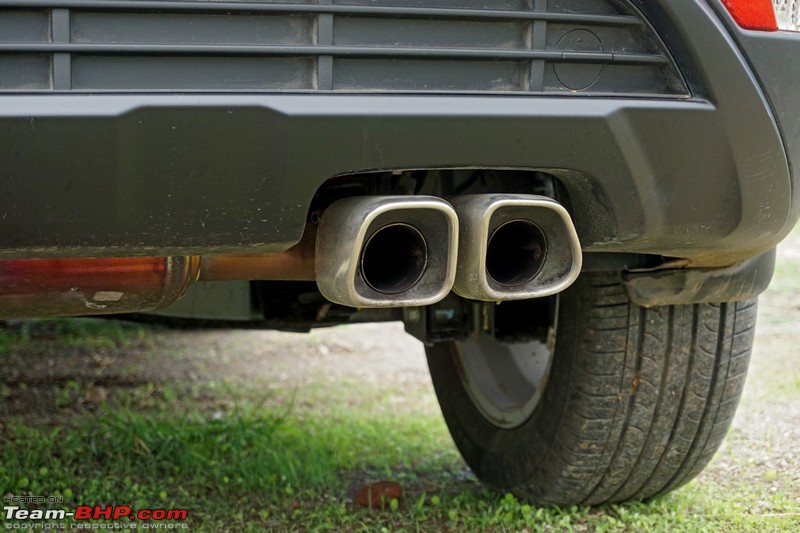 All other variants get this silver skid plate that hides the exhaust tip: 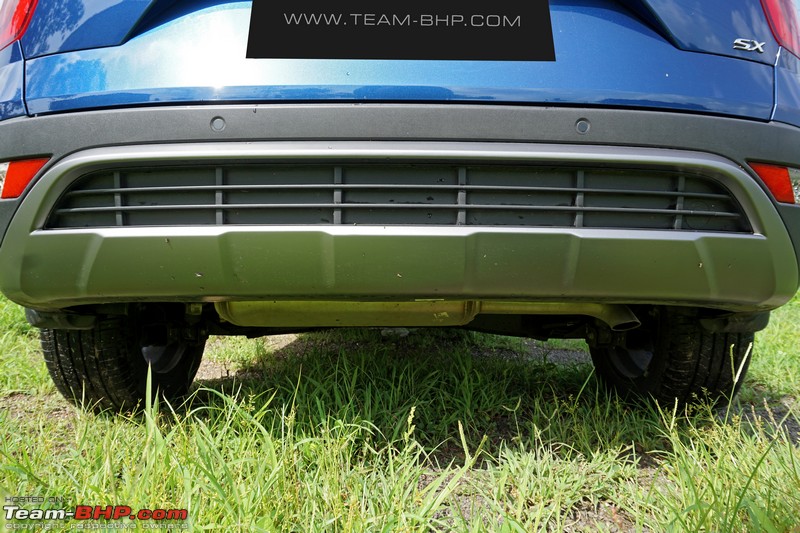 A closer look at the detailing in the reversing lamp and reflector: 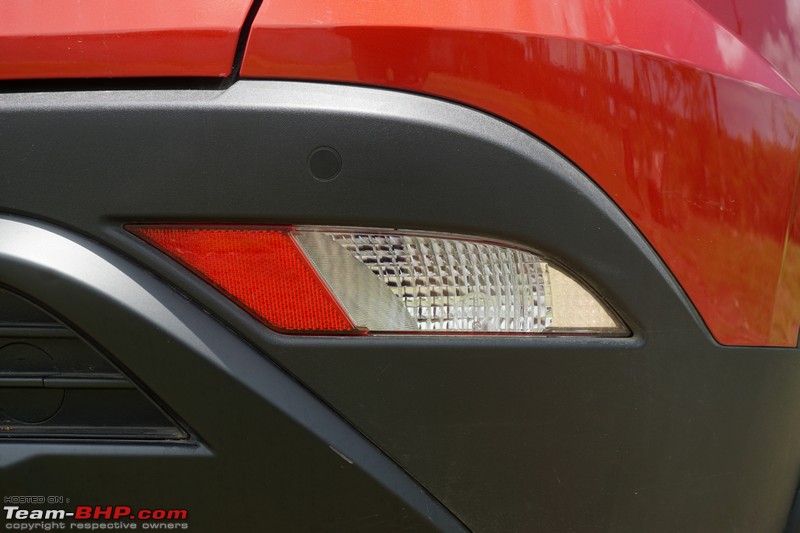 Towing point is located on the right. The cap has an arrow indicating where you should press to remove it:  While the Creta has a love-it-or-hate-it design, the Seltos is more appealing to the customers. In fact, a majority of BHPians say that the Seltos will outsell the Creta in this poll. Going by the Creta's post-lockdown sales though, Hyundai might prove them wrong! 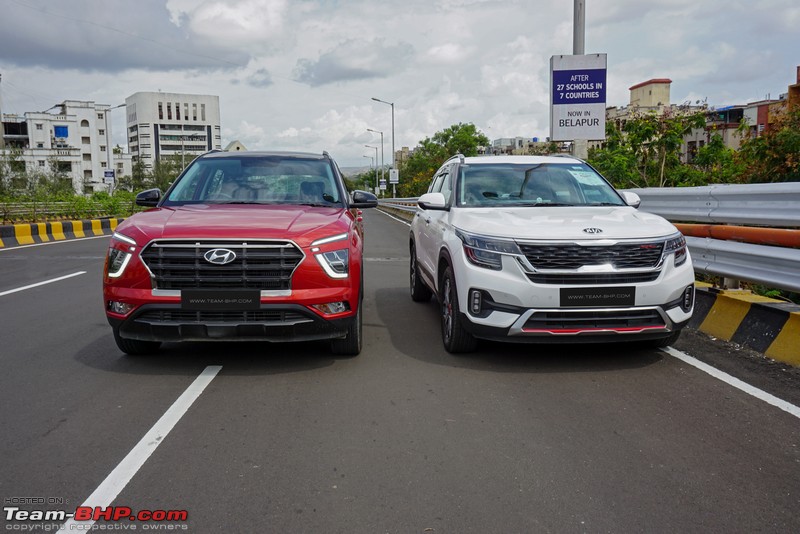 Even with the chrome, it’s the Kia that looks better from the rear: 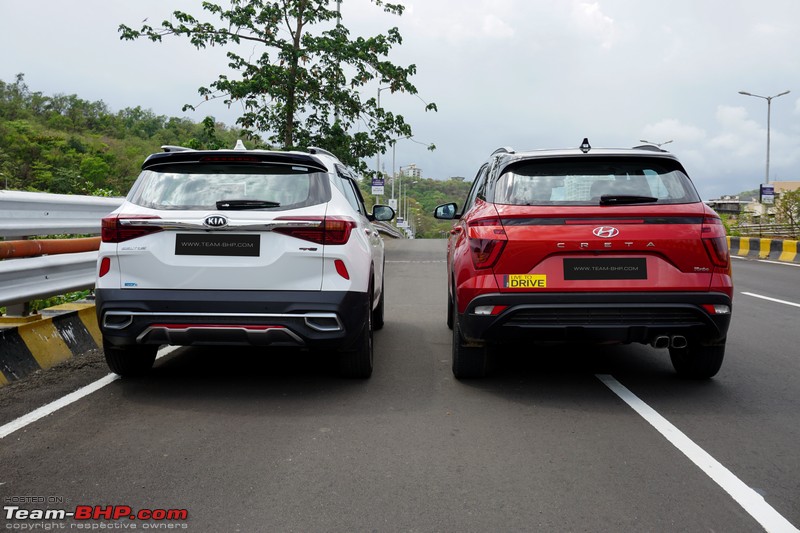 Side profiles: 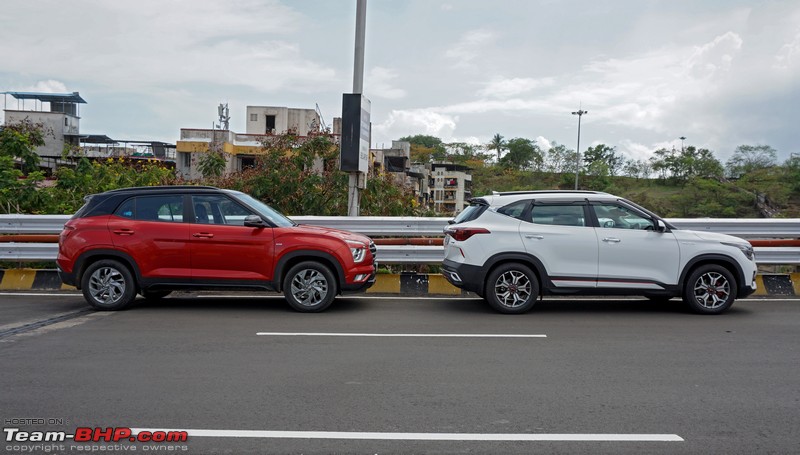 IMO the first-gen Creta looks better than the new car and its design language appealed to more people which added to its success. But there's no denying the fact that the new car's different styling gives it amazing street presence. We might not be fans of the design, but we do like its stance:  While the second-generation car is longer and wider than the first-gen Creta, it is shorter in height by 30 mm:  Last edited by GTO : 17th November 2020 at 07:44. Reason: Link corrected |
| |  (49)
Thanks (49)
Thanks
 |
| The following 49 BHPians Thank ChiragM for this useful post: | akshay81, Amity, Arnav Vaghela, ashis89, Bibendum90949, CarguyNish, CEF_Beasts, Dani7766, daretodream, dark.knight, Gaboonviper04, GTB, GTO, guyfrmblr, haisaikat, HP-BHP, InControl, irajput, jailbird_fynix, janakiram_m, lemedico, Leoshashi, mh09ad5578, mr_freakky, MSAneesh, N33raj, Nazaar25, noopster, Ponbaarathi, Prakritij, Puffdamgcdragon, Punatic, RaghuVis, RavenAvi, regenitin, Reinhard, Researcher, S.MJet, searacer932, shipnil, Shyam96, Simhi, swiftnfurious, The Rationalist, vaasu, vb-saan, Venkatesh, vsrivatsa, yajaman99 |
| | #4 |
| Senior - BHPian Join Date: Apr 2018 Location: Bangalore
Posts: 1,565
Thanked: 17,813 Times
| Interior - Front  The front doors of the Creta open and shut in a triple-stage action. They have a decent weight to them and aren't as light as in some other Asian cars. The doors open wide enough and the roof is high. So, occupants will not have any problem while getting in or out. On the inside, the car has good legroom and headroom. Even taller occupants will find it comfortable. The front windshield is large. Though the roofline slopes down and the rear windows are small, thanks to the panoramic sunroof, there's enough light entering the cabin. This greatly helps in reducing the claustrophobic feeling that the black interior may cause. Only the turbo-petrol gets an all-black theme on the inside. The other variants get a dual-tone black and greige (grey+beige) colour scheme. Interior ambience is a BIG step up from the outgoing Creta. While the exterior may not be to everyone's taste, the interior design of the Creta is neutral and would appeal to more customers. The all-black colour scheme comes with red accents and silver inserts. The doorpads, seats, carpets and floor mats are black as well. Compared to the cabin of the Seltos which gets away with the excessive use of piano black (or glossy black) finished surfaces in the cabin, the Creta is completely devoid of these. In the right amount, these touches make the cabin feel premium. There are no soft-touch plastics used anywhere, but everything you are likely to touch is of very good quality. It's only some plastics, like those used on the lower side of the dashboard and the plastic panel of the climate control, that seem like they are from a vehicle a segment lower. We feel Hyundai should start releasing more soft-touch surfaces in its 15-lakh rupee cars. The seats get leatherette upholstery and there is some leather applied on the door armrests, central armrest, as well as the gear knob and steering wheel. Ergonomically, the cabin is well laid out and all controls are easy to find / reach. You'll find your perfect driving position within minutes. The feel, quality and finish of the buttons is very good and they feel like they are built to last. Typical Hyundai quality. Additionally, Hyundai has loaded the car with features such as auto headlamps, auto-dimming IRVM, electrically adjustable and ventilated front seats, cooled glovebox, a 10.25-inch touchscreen head-unit with telematics (Blue Link), 8-speaker Bose sound system, panoramic sunroof, wireless mobile charging and an air purifier. However, some features such as auto wipers, and illumination for the glovebox are conspicuous by their absence. A look at the dual-tone black and greige colour scheme: 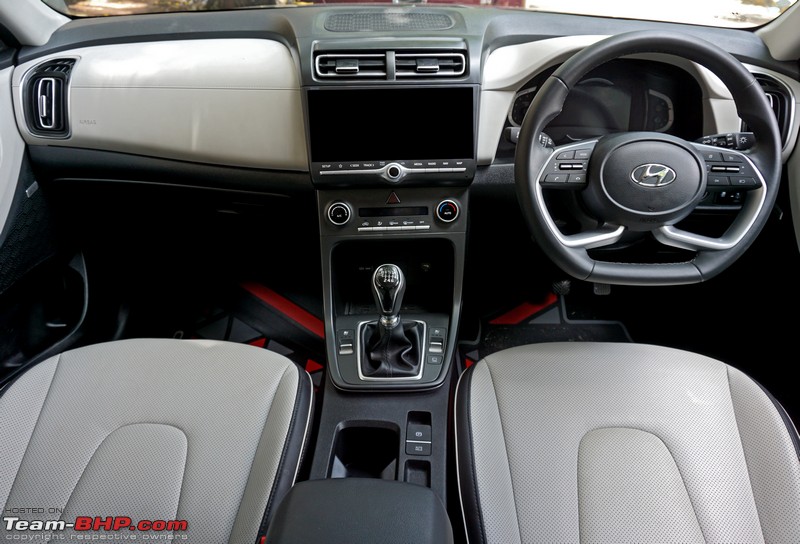 The dashboard is well-screwed together and nicely finished. One can't find any rough edges anywhere:  Windscreen is large and the seating position is a little high up. The head-unit is placed lower than in the Seltos which aids frontal visibility: 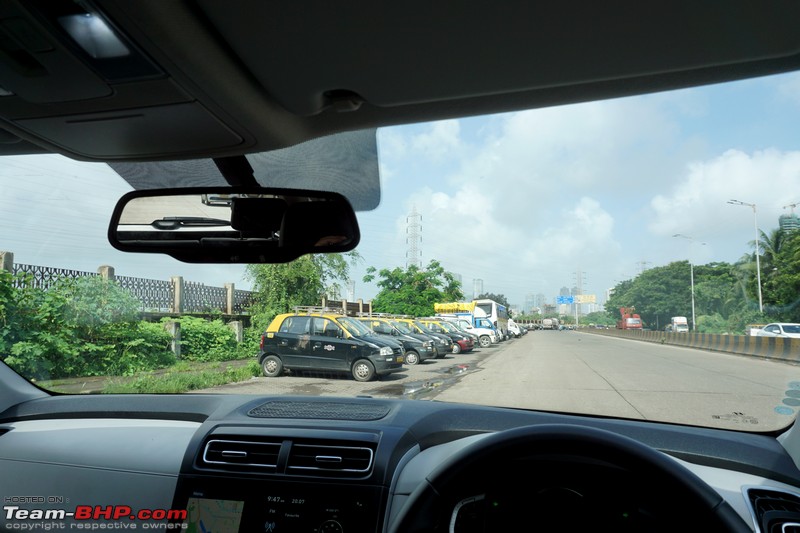 A-pillars aren't excessively thick and do not cause big blind spots. This is one of those rare modern cars with excellent all-round visibility. Usually, we see the odd blindspot due to ever tightening safety norms and thick pillars:  Leather-wrapped 4-spoke flat-bottomed steering wheel is lovely to hold and offers good grip. I would have preferred the 3-spoke steering wheel you get on the Venue, which looks smarter. The brushed silver insert on the bottom two spokes does look good and the steering-mounted controls are big and easy to operate:  Buttons for the infotainment system, telephony and voice commands are placed on the left spoke. Mute function (very useful) is activated by pressing the volume switch inward. Pressing the mute button also pauses the song that's playing, so you don't miss any part of it. Like we have seen in some new cars, to go to the next track, you have to push the track button down (opposite of what is usually the case). Looks like a new trend is being adopted by manufacturers. Buttons for operating the MID and cruise control are placed on the right spoke. The horn pad isn't easy to reach for those with shorter thumbs:  Paddle shifters on both sides of the steering wheel in the turbo-petrol variants. Another unique feature that the Creta's main rival, the Seltos does not get. Pull the one on the left to shift down and the one on the right to shift up:  Zooming in to show you the red contrast stitching on the steering wheel:  A look at the stitching on the steering wheel in the dual-tone interior cars:  Steering can be adjusted for height, but not for reach - even in the top-spec! This is a shocking omission as reach-adjustable steering greatly contributes to the 'perfect' driving position. The Kia Seltos gets it and even the cheaper Elite i20 gets it. For GTO, in his laid back driving position, the steering was a notch too far. Hyundai ought to realise that such cost-cutting doesn't suit its brand image:  A plain black engine start button with a silver ring around it: 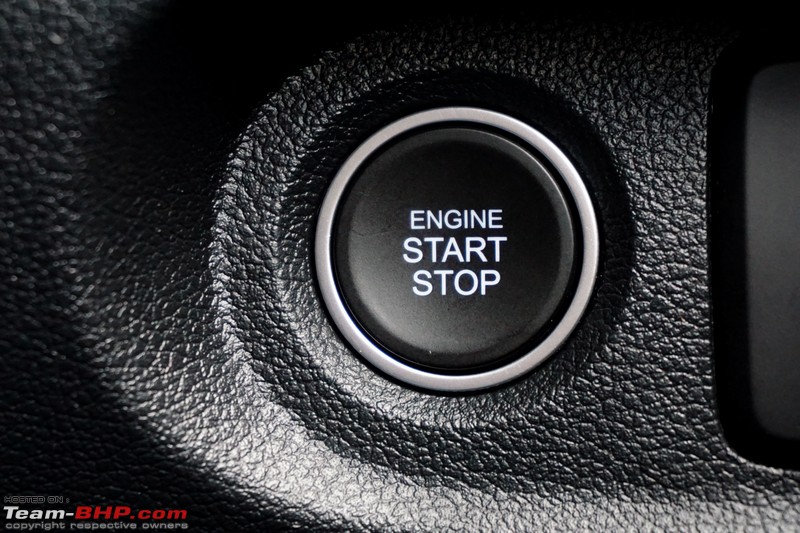 Instrument cluster consists of an analogue tachometer, as well as analogue fuel gauge with a 7-inch digital display in between that displays the speedometer. It’s also great to see an analogue temperature gauge here (related discussion). The instrument cluster has silver inserts on the top and bottom and a silver design graphic on the digital display makes it look like it is the continuation of the insert. The tachometer is small and difficult to read. It should have been a size bigger. Along with the speedometer, the digital display also shows the range, odometer and the outside temperature: 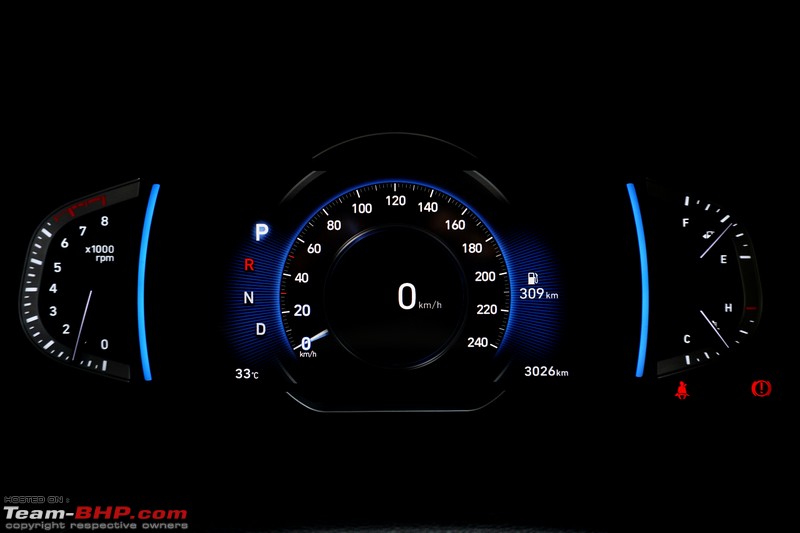 Nice graphics when you start the car: 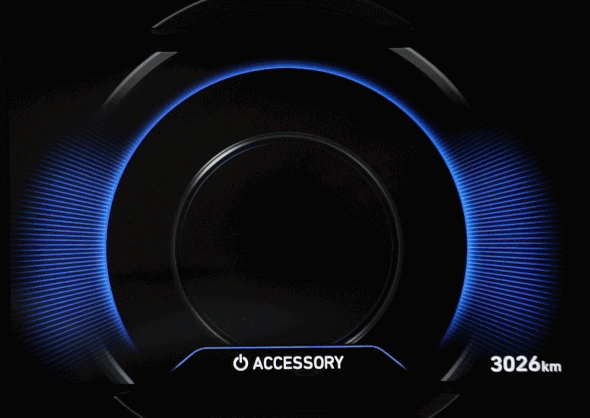 The MID shows average and instant fuel consumption, a single trip meter, and a digital speedometer. The trip meter shows the distance travelled, average consumption and time taken:  MID has a parking sensor display that comes up when reverse gear is engaged. Other readouts include a tyre pressure monitoring system (TPMS) and compass (pointless on a FWD car):  The MID also displays the position of the lights and the front and rear wipers (as you adjust their respective stalks). Quite cool! These readouts appear for a few seconds whenever the positions are changed. The MID further shows a summary of the drive when you switch the car off: 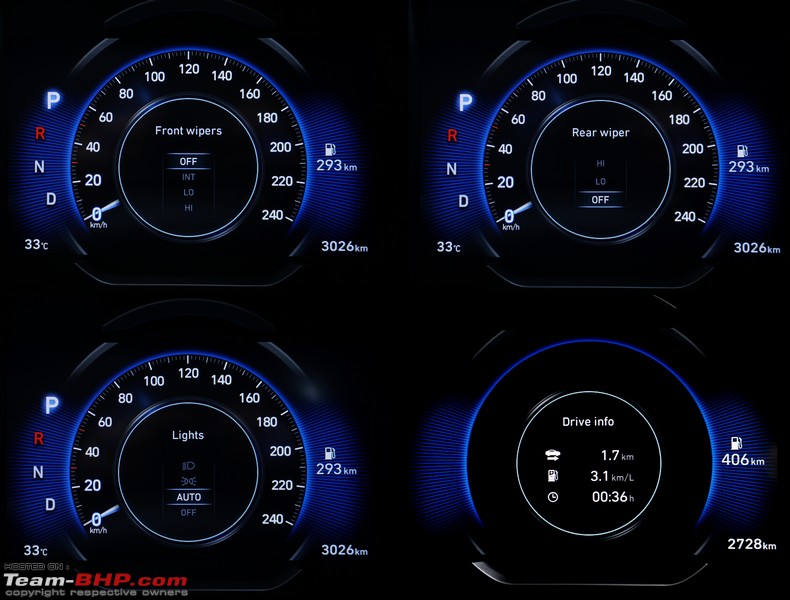 The radio station selected or the song that is being played is displayed for a few seconds when you change the station / song:  Navigation directions along with the distance and time to the destination are also displayed on the MID. It also shows the distance to the destination when the destination is set:  MID displays the specific open door. It covers the tailgate too. The system sensibly warns you if the sunroof is open, only when the engine is switched off. Surprisingly, there is no warning for the bonnet; even the Venue gets it: 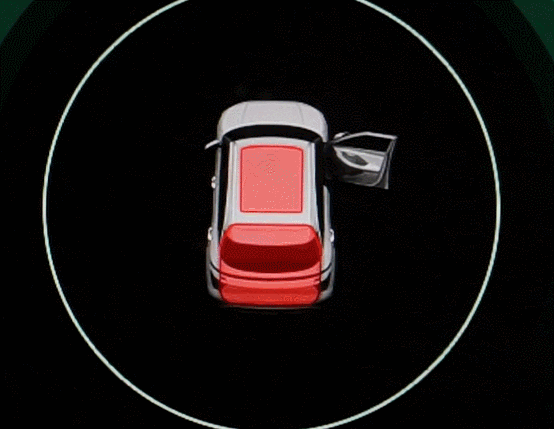 Stalks exude quality. Wiper and light stalks are shared with some Hyundai cars. Quality is excellent and the operation is soft. While automatic headlamps have been provided, automatic rain-sensing wipers have been left out. Sucks as we find auto-wipers to be incredibly useful in the monsoons. Foglamp switch is nicely integrated on the RHS stalk. Lane change indicator is standard on all variants:  Rectangular air vents get a red accent and a silver border. The flow of air can be shut by moving the direction controller down. However, even with the vents in the full shut position, some air keeps flowing out:  Switches for the traction control and the headlamp level adjuster are placed below the vents, next to the engine start button. Don't ever disable the traction control, unless starting on slippery surfaces like slush and snow: 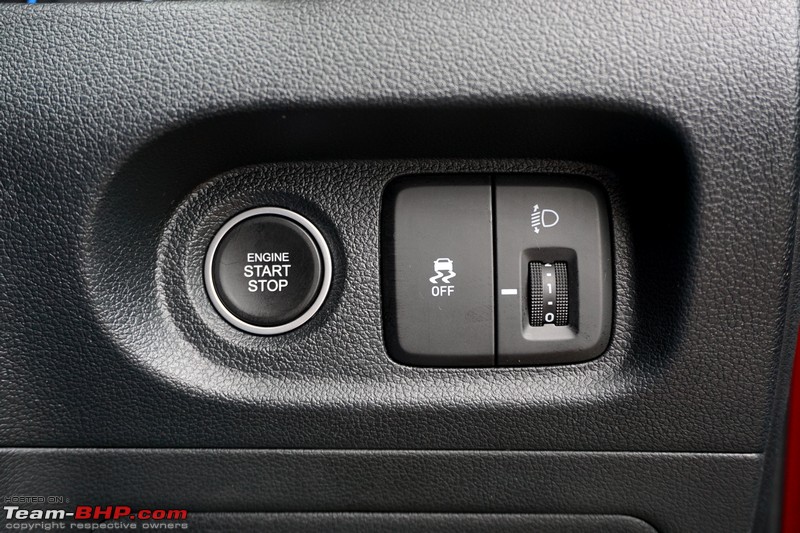 Black OBD port is located to the right of the fusebox: 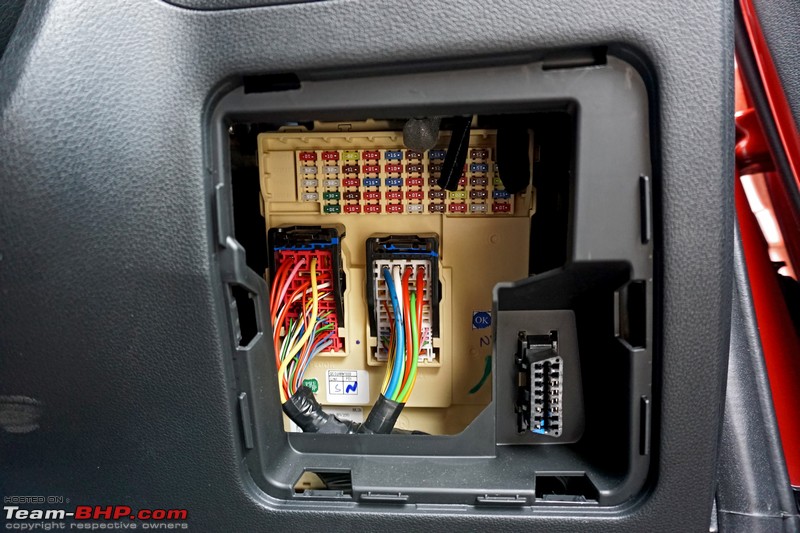 Thin, yet sturdy bonnet release lever is located below the dash:  Fuel flap release is placed conventionally on the floor:  Like the dashboard, the doorpads get an all-black colour theme. This will prevent them from getting soiled. The doorpads are well finished with no sharp edges anywhere. Tweeters and front speakers are housed in the doorpad:  A look at the dual-tone doorpads: 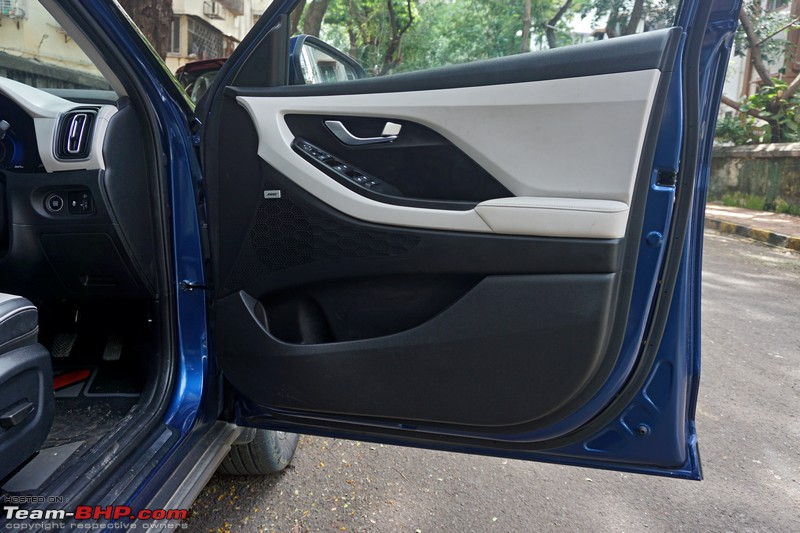 Metal finish door handles are available on the S, SX, and SX(O) variants:  The console houses the usual set of buttons. Only the driver's window gets one-touch up / down and anti-pinch functionality and that's the only button on the console which is backlit. This car is so loaded, but something as practical and convenient as illuminated switches are missing!! Door mirrors are electrically foldable. ORVM adjuster selector switch is weird. One of the two mirrors is always selected - there is no middle / dead position. So, if by chance, you press the adjuster, one of the mirrors will change its angle: 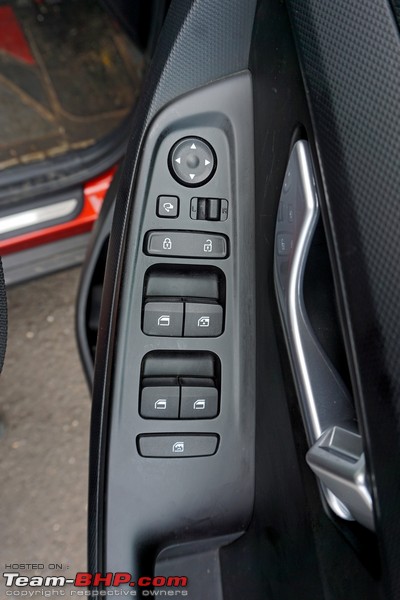 A storage space ahead of the armrest can hold small items:  The door armrest is finished in leather and gets red contrast stitching:  Doorpad can hold a 1-liter bottle and other small items. You can squeeze in a smaller bottle on the side:  Running board is not wide, making ingress / egress easier. The SX and SX(O) variants get aluminium scuff plates: 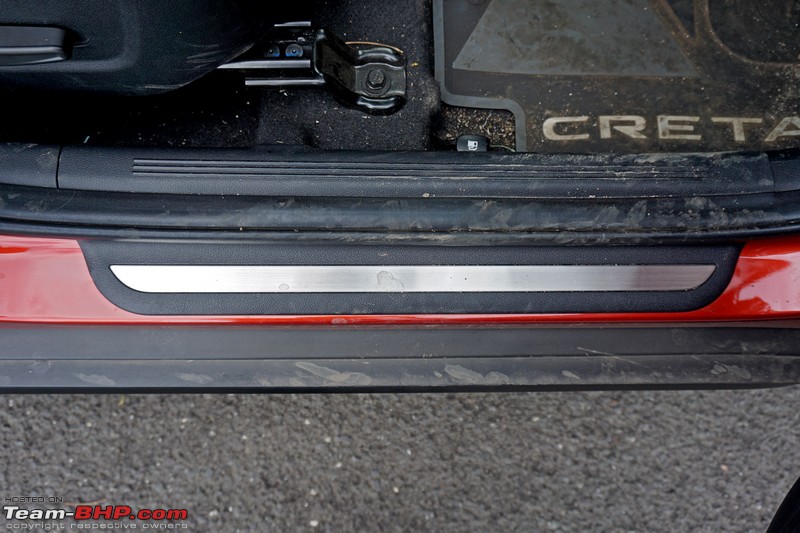 Black front seats of SX(O) variant of the turbo-petrol cars are draped in leatherette upholstery. The seats come with a cooling function which prevents the user's backs from perspiring. Such a boon in hot Indian summers. Front seats are very comfortable and even heavier drivers will be more at home here than in the Seltos’ driving seat. GTO felt the lower back support in this Creta to be better than in the 1st-gen car:  Grey and black upholstery in the dual-tone variants: 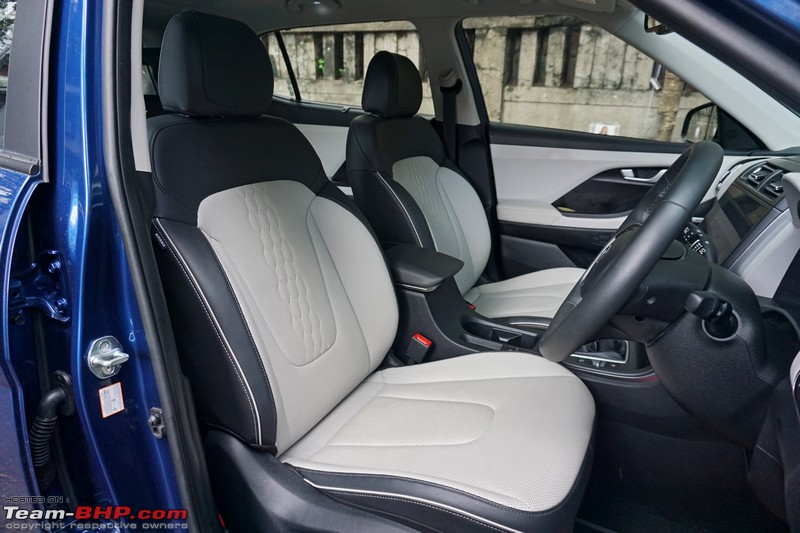 Driver's seat is 8-way electrically adjustable with no lumbar adjustment (not even manual). These switches feel sturdy and durable. Finding a comfortable driving position is super easy:  Fore and aft travel range is enough to accommodate tall and short drivers alike:  Height adjustment range is healthy as well. Short or tall, no one will complain:  Basic manual adjustments for your spouse / date: 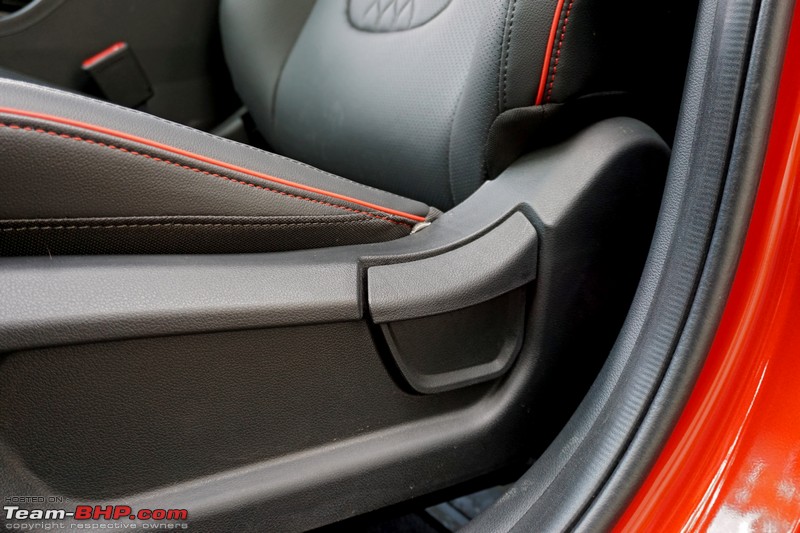 A look at the pattern on the leather seat upholstery. Perforated material is mandatory for the seat's cooling function. Good quality materials are used here:  A look at the pattern on the seatback:  Red contrast stitching and red piping look nice:  Center armrest has a soft leather cladding with red stitching. While it is not adjustable, the armrest is conveniently placed and most medium to tall drivers will find it comfortable to use, but shorter drivers would have preferred it a little more ahead. Which is why in a car as well-equipped as this, an important driver tool like this should have been adjustable:  Seatbelts are height-adjustable. Both front seatbelts get pre-tensioners: 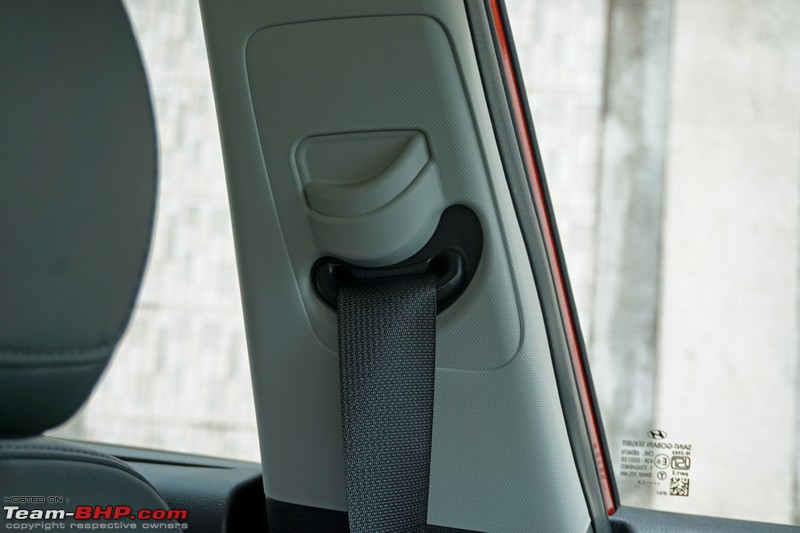 Pedals are properly spaced out. A very usable dead pedal has been provided as well. The pedals of the turbo-petrol variants are finished in sporty aluminium with black rubber grips: 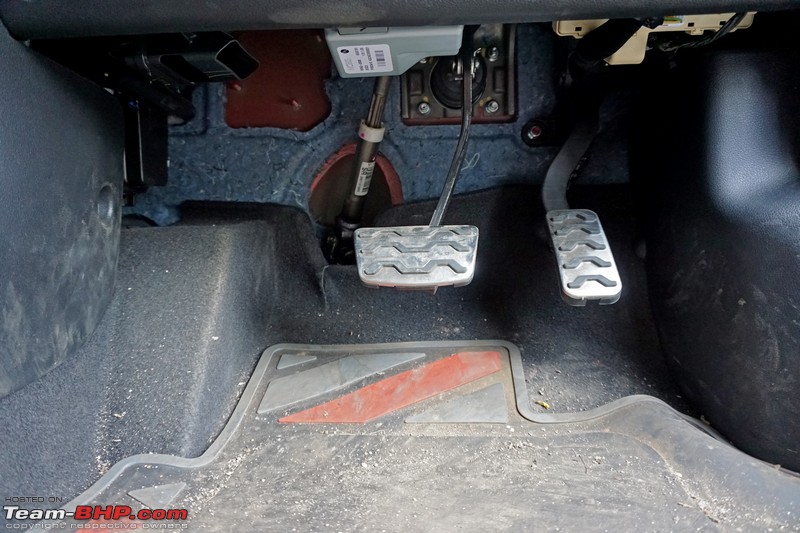 Pedals in the non-turbo-petrol variants have regular black rubber grips: 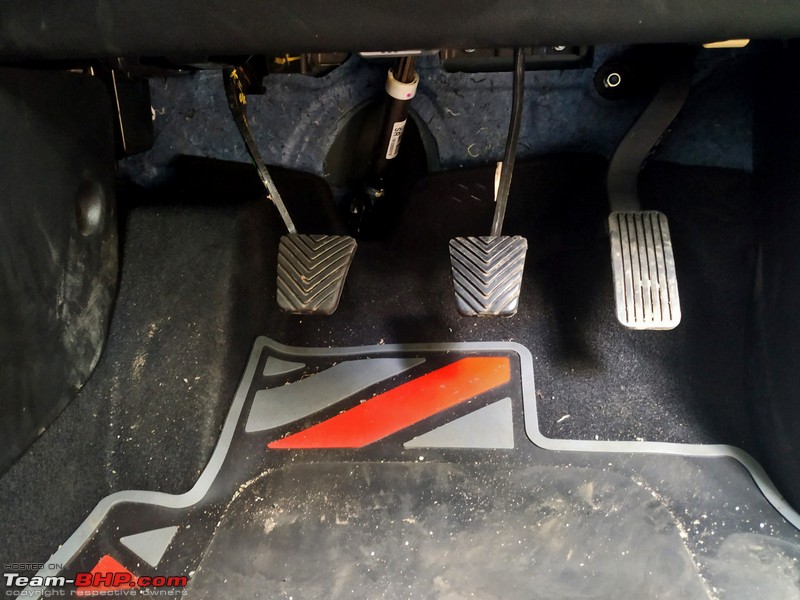 ORVMs are wider than what we usually see and are sufficiently tall as well, giving a good view of the action behind:  IRVM is very unique and looks upmarket. It is wide enough to cover the entire rear windshield. Rear headrests and thick C-pillars restrict visibility though:  Like we saw in the Hyundai Venue, the IRVM houses 3 buttons - SOS button will place an emergency call to Hyundai customer care, the button with the tow truck will call Hyundai Roadside Assistance and the third button will launch Blue Link. An auto-dimming function has been provided as well: 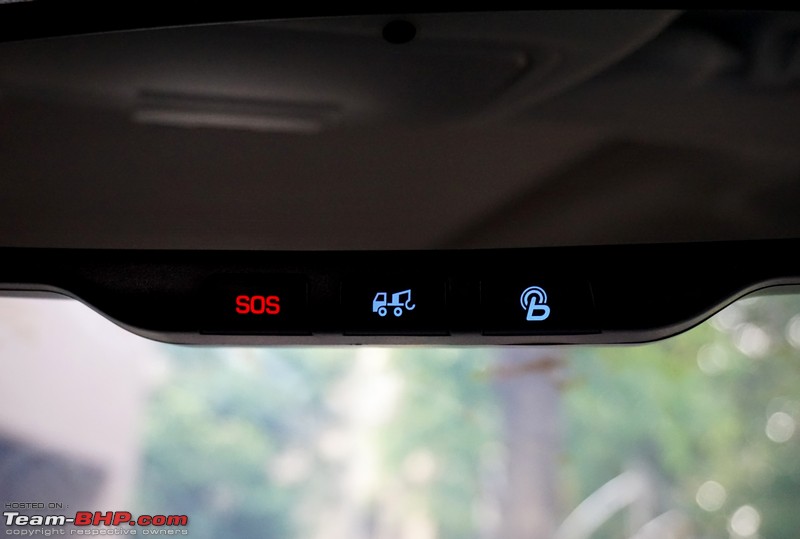 Like most crossovers, the rearward view is average at best. The rear windshield is fair in size, but thick C-pillars mean it’s better to rely on the reversing camera and parking sensors:  The rather bland center fascia tilts slightly towards the driver. It features a 10.25-inch touchscreen head-unit and a silver trim around the gear lever: 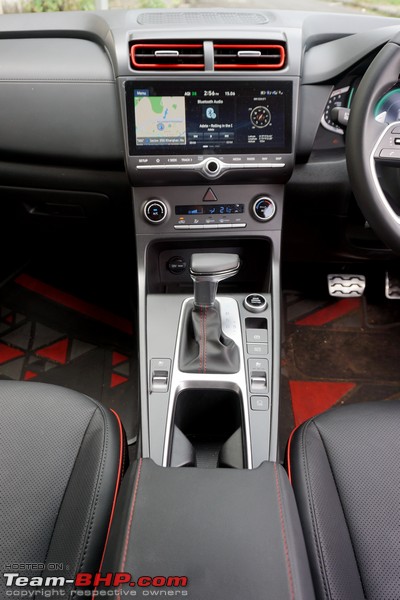 Rectangular central air-con vents get a chrome trim on the adjustment knob and red inserts as well:  10.25" touchscreen head-unit has been covered in a separate post later in the review:  Hyundai has equipped the Creta with Eco Coating - a technology that is claimed to eliminate air-conditioner odour. Climate control display looks like it is from a segment below. Too small! This is perhaps the sole complaint we have with the cabin. Even the knurled knobs are a size too small: 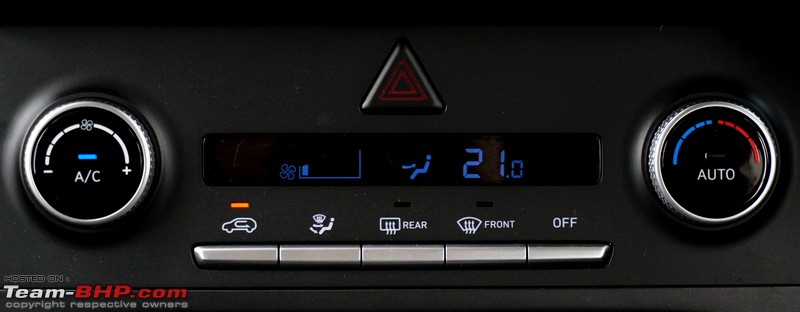 2 USB ports and a 12V power outlet are located below the climate control panel. The USB port on the right can only be used for charging, while the one in the middle can be used to connect your smartphone to the infotainment system (e.g. Android Auto): 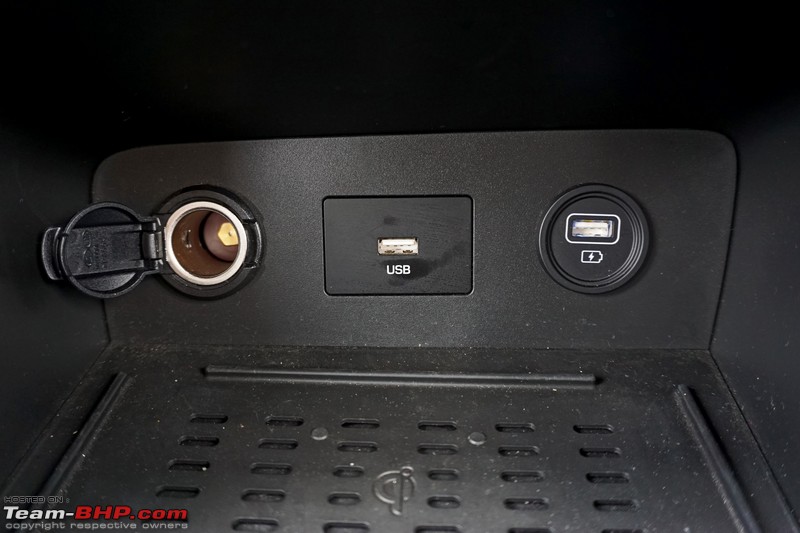 Wireless smartphone charger is placed at the base of the center fascia. Remember, your smartphone needs to have the wireless charging function for this feature to work:  Bird's eye view of the center console. E-brake releases a lot of space but we would have preferred it in a different location (related discussion): 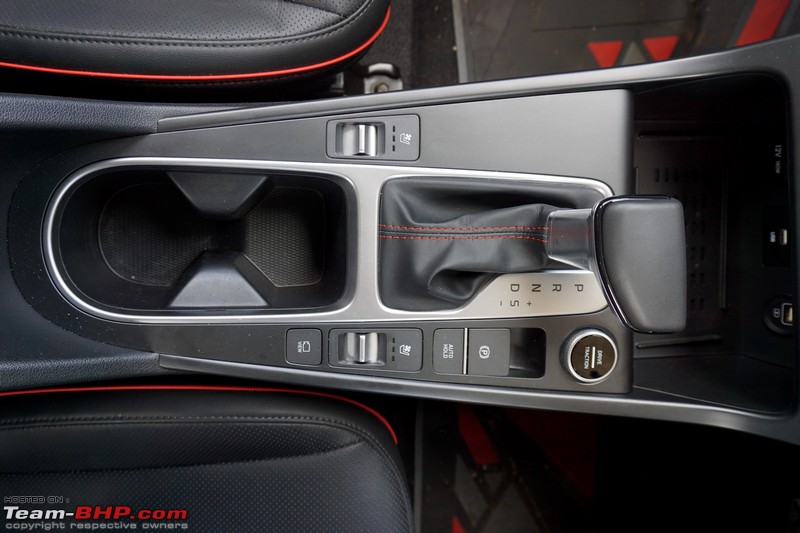 Bird's eye view of the center console in the diesel manual variant: 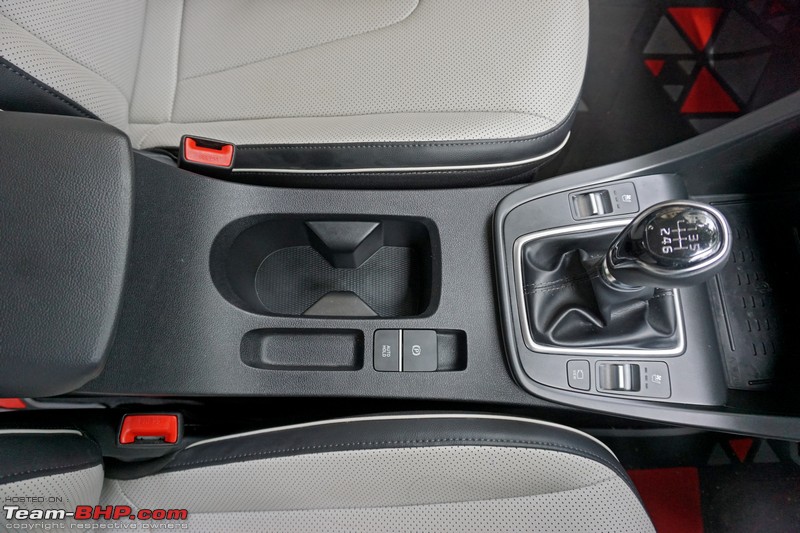 Toggle switches for the front seat ventilation system along with buttons for the rear camera view and auto hold as well as the electronic parking brake are located on the center console:  Two cup-holders on the center console below the gear lever:  The vents for the air purifier system are placed at the front and the rear of the center armrest…  …while the intake vents are placed on the side: 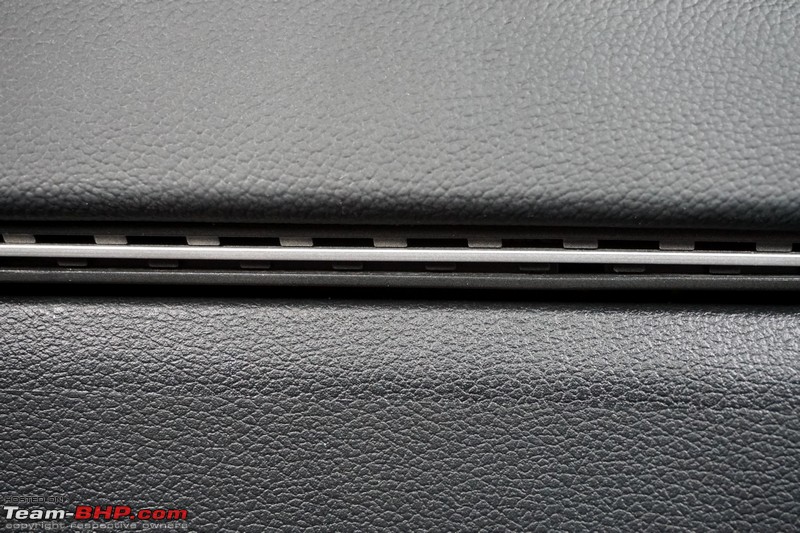 A cabin air purifier with a perfume dispenser was first seen on the Seltos and the Creta gets it too. It’s placed below the center armrest and can be activated through the ICE head-unit. The air quality index is displayed on the head-unit as well as a small screen on the center armrest (for rear-seat passengers to see):  Remove the cover to gain access to the filter: 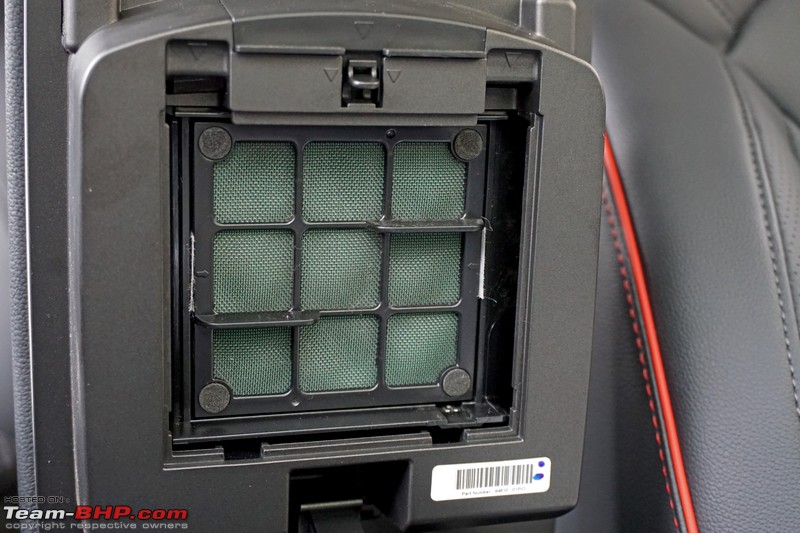 Fan speed can be altered as well (through the head-unit): 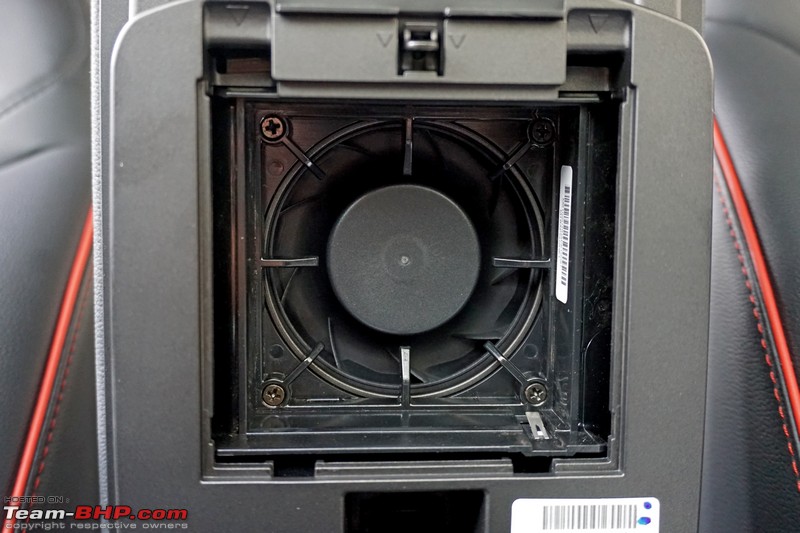 The filter can be removed for cleaning. The infotainment head-unit will tell you (in the number of hours) when you need to clean it: 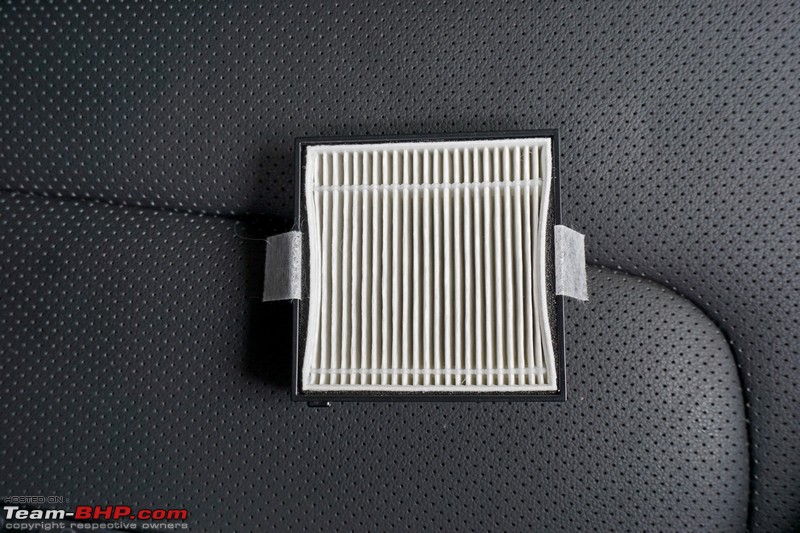 Perfume cartridge is placed above the fan: 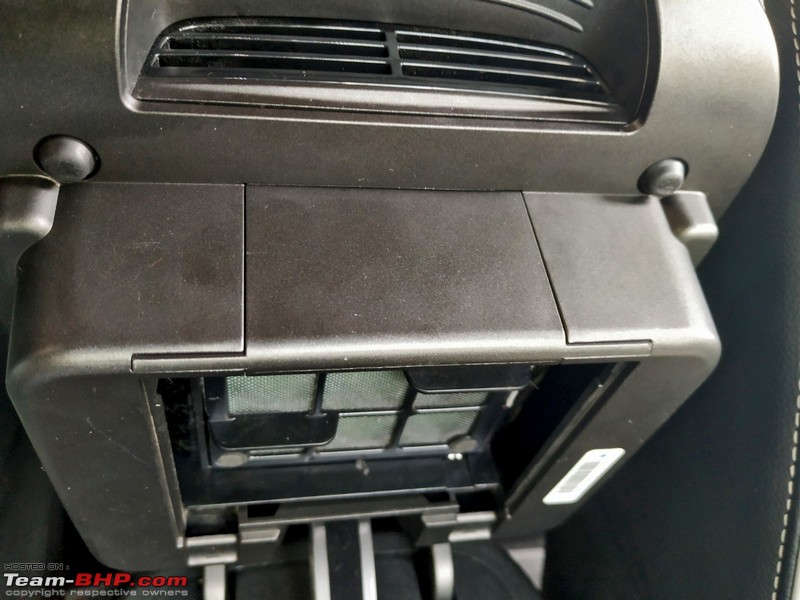 It has holes which are covered with tape (remove all if you like it strong): 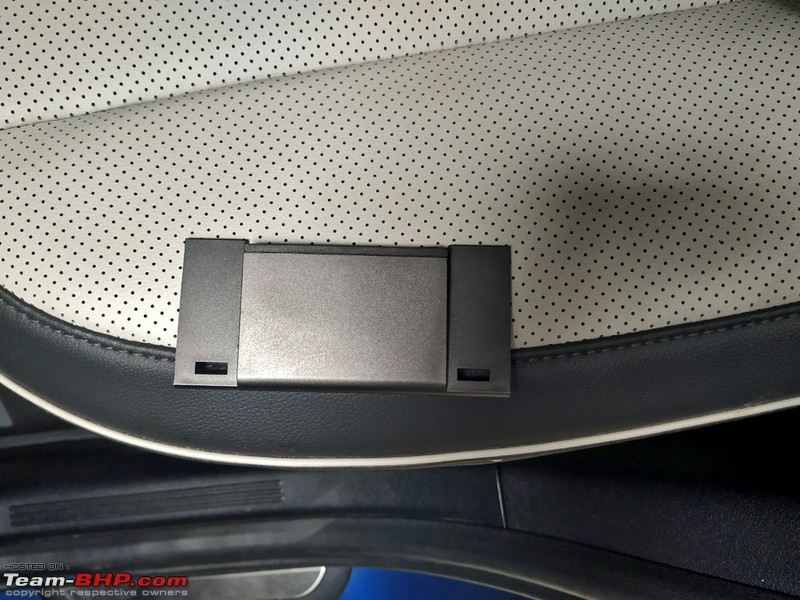 Center armrest has a deep storage compartment underneath. It has a soft lining on the floor:  Hyundai could have added a storage space like in the Venue for added convenience of the passenger and to make it a bit more interesting: 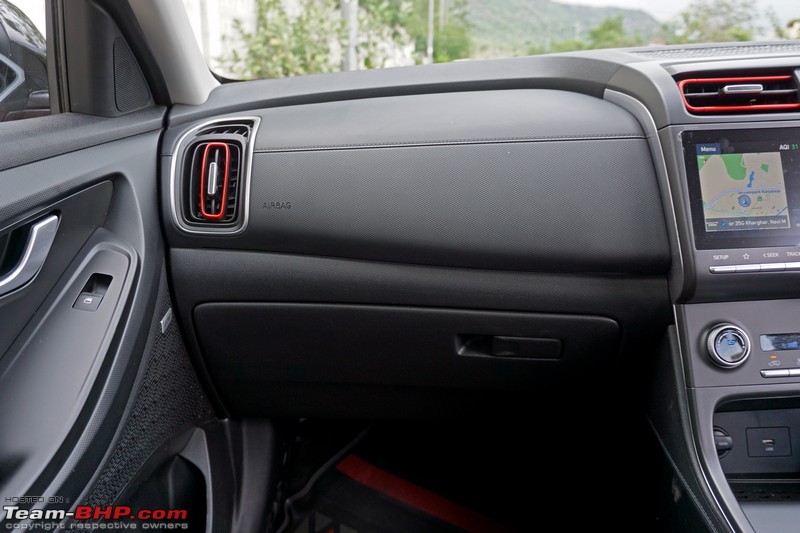 Glovebox is less accommodating than the 1st generation Creta and there is no illumination - a feature that is expected from a car in this price bracket: 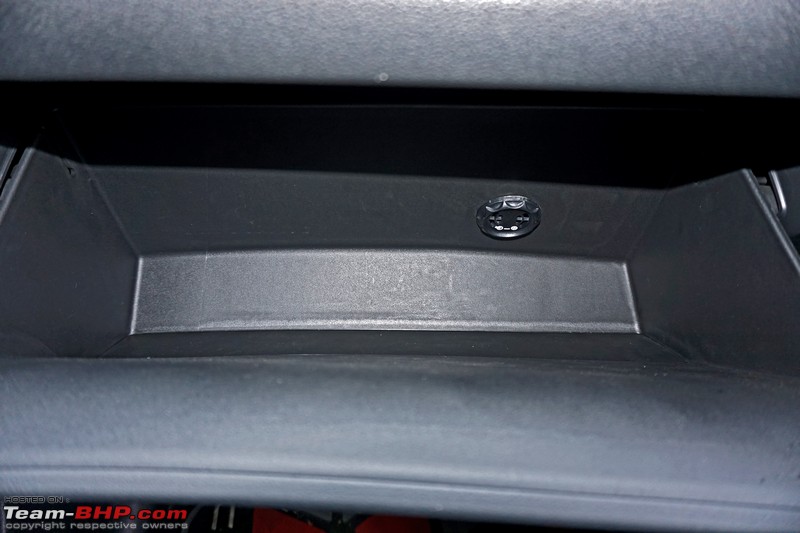 However, the glovebox is cooled:  Roof bezel consists of map lights and sunroof controls, Bluetooth mic and sunglass holder. You can start the rear cabin lights as well from here:  Sunglass holder has a soft opening action, and a protective lining on the inside to prevent your sunglasses from getting scratched:  Sunvisors are economy-grade in design, yet they don’t feel flimsy. Driver-side unit merely gets a flap to hold tickets (no mirror or illumination):  Passenger-side sun visor gets a vanity mirror, but there's no cover or light provided:  Dual airbags are standard on all variants of the Creta. SX(O) trim gets 6 airbags in total. These include… 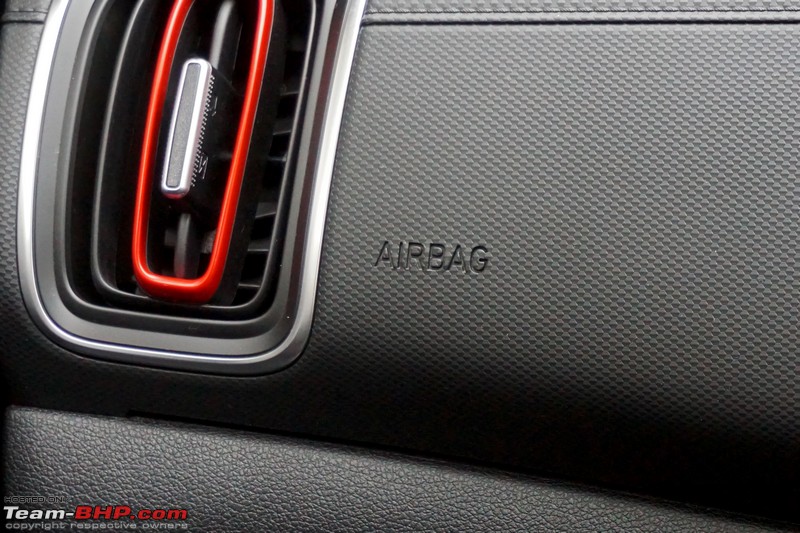 …side airbags (no seat covers here please)…  …and curtain airbags:  The fabric cover for the voice-enabled panoramic sunroof is electronically operated. It’s got the “wow” factor and also makes the cabin feel super airy. Your family will love it:  The sunroof spans the length of the cabin and lets in a lot of light: 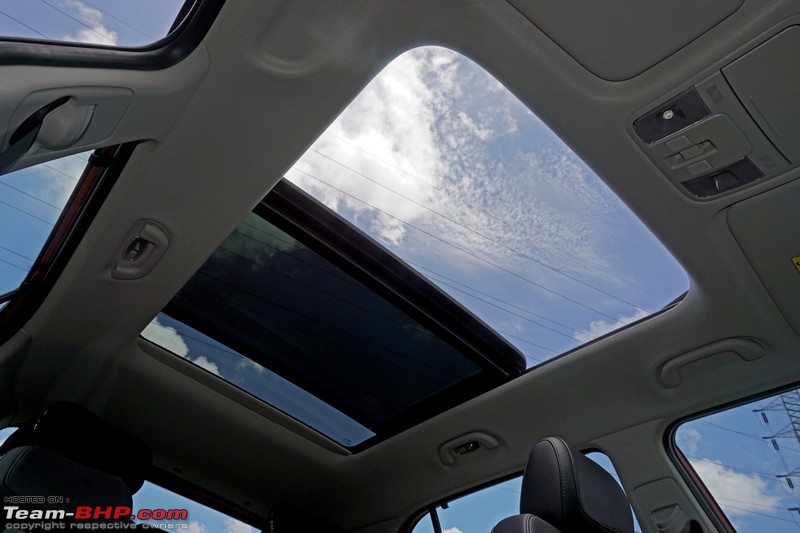 Only the front half opens up. You can pop the sunroof up for ventilation: 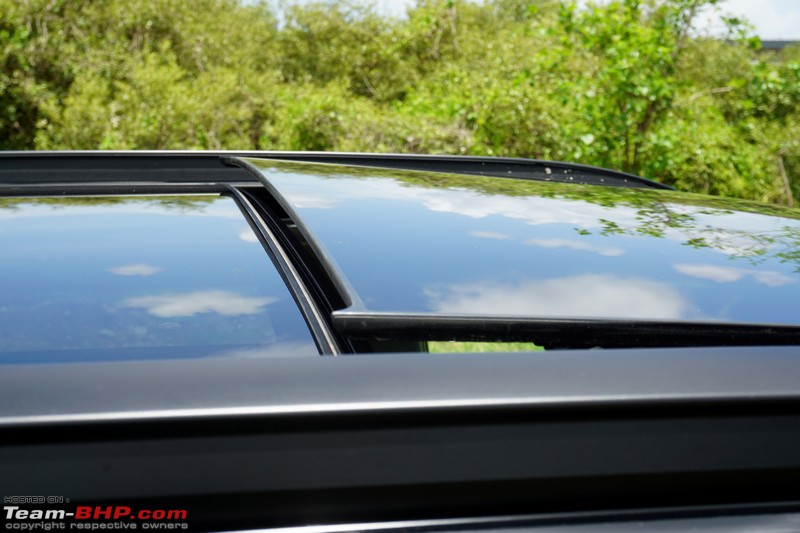 The front portion slides over the rear (we don't like this about panoramic sunroofs - looks ugly from the outside). A wind deflector pops up the moment the sunroof is opened:  Things are organised even in places where most owners won’t look. No loose wires or cables are dangling anywhere. Here's a look below the dashboard in the driver's footwell... 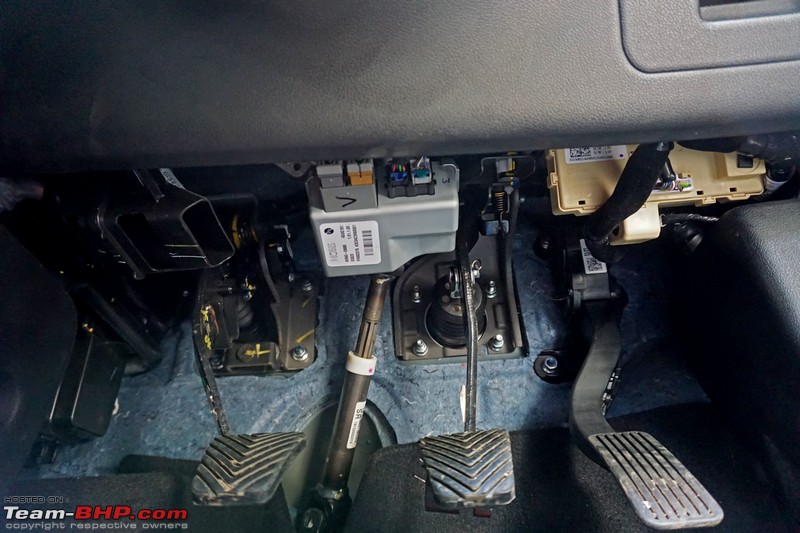 ...and the passenger's footwell: 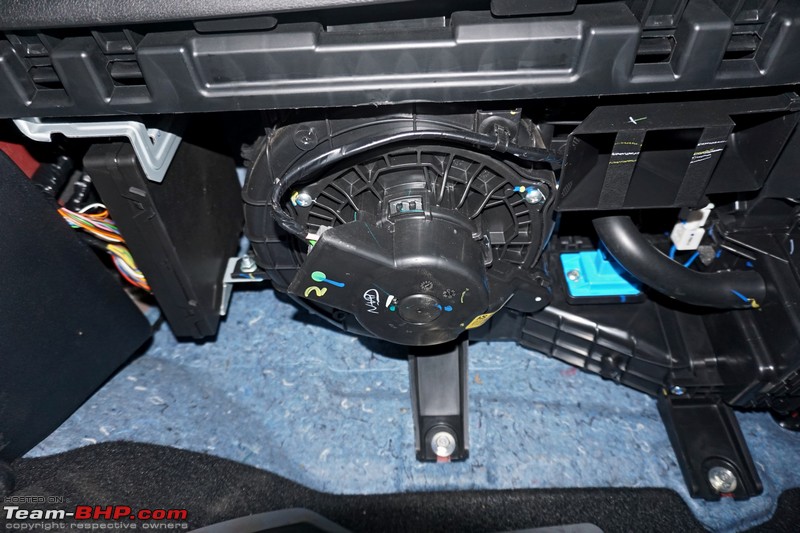 Last edited by Aditya : 17th September 2020 at 10:45. |
| |  (32)
Thanks (32)
Thanks
 |
| The following 32 BHPians Thank ChiragM for this useful post: | akshay81, Amity, arjab, Arnav Vaghela, Bibendum90949, CarguyNish, Col Mehta, daretodream, dark.knight, GTB, GTO, guyfrmblr, InControl, jailbird_fynix, lemedico, Leoshashi, MMV, MSAneesh, Nazaar25, Puffdamgcdragon, RavenAvi, Reinhard, Researcher, S.MJet, sairamboko, Simhi, swiftnfurious, vaasu, vb-saan, Venkatesh, vsrivatsa, yajaman99 |
| | #5 |
| Senior - BHPian Join Date: Apr 2018 Location: Bangalore
Posts: 1,565
Thanked: 17,813 Times
| Interior - Rear The rear doors of the Hyundai Creta open and close in a two-stage action. They swing out sufficiently wide and the floor isn't too high off the ground. This makes ingress and egress convenient: 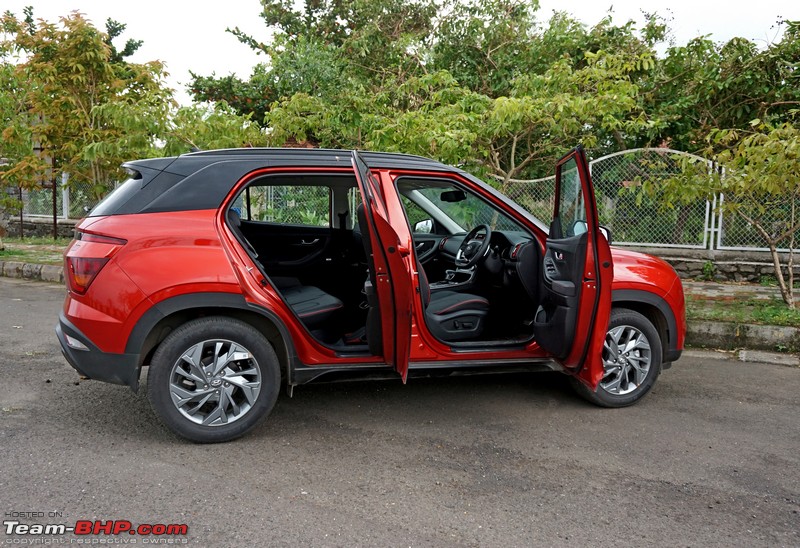 There is enough space between the seat and the B-pillar to move your feet in and out:  The door sills are not too wide. Just like the front door sills, the rear door sills get an aluminium scuff plate:  Just like the front doors, the rear doors get an all-black theme. The design is bland and doesn’t feel very premium:  Door pockets can hold a 1-liter bottle and some knick-knacks:  The seat has contours for support and is better for 2 adults and a kid (rather than 3 healthy adults). Also, the middle area of the backrest protrudes (due to the armrest). It is hard and flat and the middle passenger will not be the most comfortable:  A look at the rear seat in the 1.5L petrol and diesel cars:  Legroom is healthy and two 6-footers can sit one behind the other in reasonable comfort:  Only the side passengers get headrests. They also get three-point seatbelts, while the middle passenger gets a lap belt. The rear seat is well cushioned and is noticeably superior to the Seltos. However, it’s weird that Hyundai has started this kind of cost-cutting by not giving 3 headrests at the back (the Seltos gets three):  ISOFIX child seat anchors have been provided on both sides. This feature has been provided in the SX and SX(O) variants only:  Seatbelt buckles can be neatly tucked away into this cutout:  The seatback has a comfortable angle. Headroom is good and under-thigh support is satisfactory: 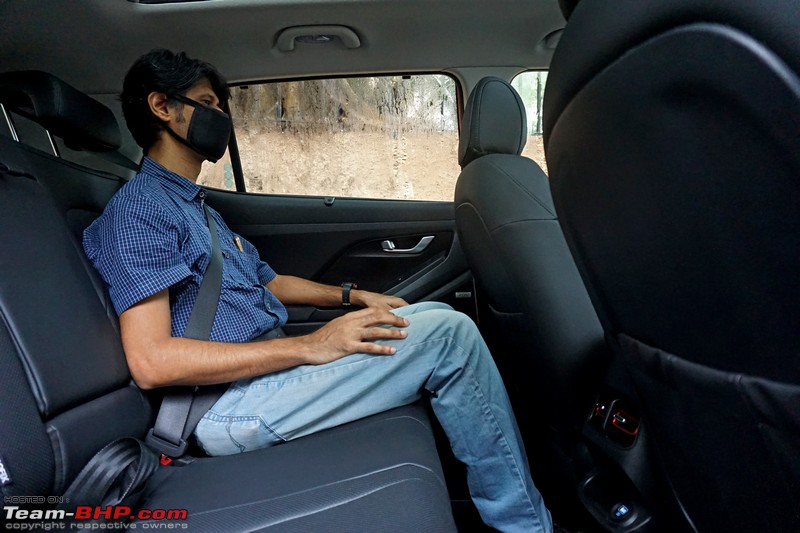 Adjustable headrests are provided in the top two variants only:  2 rear headrest cushions with 'Creta' branding are also provided. The headrests, as well as the cushions, are soft and comfortable to use:  Seatbacks have h-a-r-d plastic surfaces with two small scoops (each) where the rear passengers' knees would be placed. This hard seatback is required for the ventilated seats, but it is a BIG FAIL for rear passengers. One will hate the feel of hard plastic on his knees. Luckily, lower variants (without ventilated seats) do NOT get these rock-hard seatbacks. Both front seats come with wide and deep seatback pockets for storage: 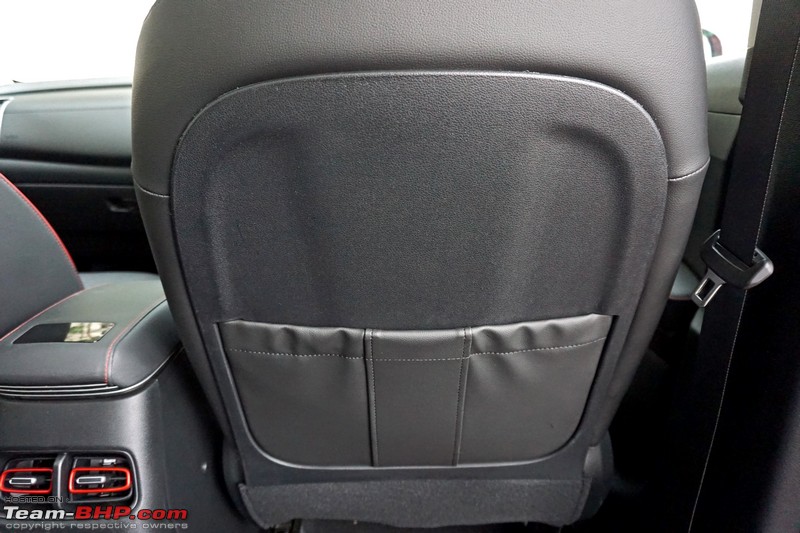 The area where your foot / shin area would meet the front seat is soft:  The center armrest is positioned at a comfortable height:  It is wide and soft, and comes with two cupholders:  Window line rises toward the rear and while the rear windows are on the smaller side, they let adequate light into the cabin. The panoramic sunroof also helps make things better for rear passengers by making the ambience airier:  Rear windows roll all the way in:  Pull-up sunshades have been provided in the S, SX, and SX(O) variants. They are super useful in these sunfilm-less times. Rear passengers will love them! See that additional horizontal strip? It is located where there is a curve on the curtain. This plastic stick adds a bit of rigidity to it, else it will fold in the long run:  Rear air-con vents are provided on all variants. They get red inserts on the turbo-petrol variants...  ...and silver inserts on the others:  A touchscreen on top of the front center armrest displays the air quality index to the rear passengers. It can be used to control basic functions like changing the mode and turning it on / off:  The rear vent for the air purifier system is placed above the air-con vents:  USB port at the base of the console for rear passengers to charge their electronic gadgets. A small cubby next to it can be used to place a smartphone while charging:  Spring-loaded grab handles have been provided above all passenger doors. The rear ones come with LED lights inside them for the passengers to use:  The seatbelts can be parked in these slots (when folding the rear seat down):  The floor hump is tall and wide. It is inclined as well. With the center console protruding back, the middle row seat passenger will have to put his feet on either side of the floor hump:  At 433 liters, the Creta's boot space is identical to the Seltos. Even the boot layout is similar. It is larger than the Harrier's boot (425 liters) but way smaller than the MG Hector's (587 liters). We frankly feel the usable space is smaller than its 433L rating would indicate. The opening is wide, which makes it convenient to load luggage:  Large parcel tray comes with a recessed area and prominent border to keep things in place. It gets strings which attach it to the tailgate and lift it up when you open the tailgate:  Removing the parcel tray makes the boot appear much bigger. This should easily swallow your family's vacation bags:  Boot light is located on the left:  Storage cubicles have been provided on either side of the boot. The one on the right side is slim and long...  ...while the one on the left is wider, but not as long:  Cargo tie-down hooks are provided in the 4 corners of the boot: 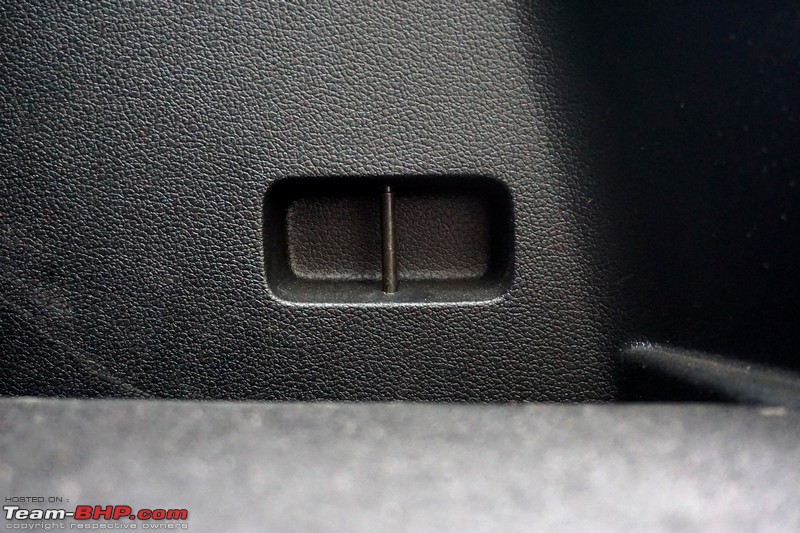 For reclining the seats, this plastic flap has to be pulled up. The same flap has to be pulled to fold the backrest down for increased cargo space:  Rear seats can be reclined individually. Here's the difference in the angles between the reclined and regular positions. The recline-adjustment can give you a comfortable recline angle:  There is a clearance between the seatback and parcel tray with the backrest in its regular position. With the backrest reclined, this gap disappears:  SX and SX(O) variants get a 60:40 split on the rear seat:  Folding the seatbacks down gives you much larger cargo capacity:  Top tether for the child seat (there's one on each side of the rear seat):  Pic taken from the inside with the tailgate shut. The loading lip is not high and is almost level with the boot floor. Makes it easy to take your bags out:  Only the lower part of the tailgate gets cladding on the inside. We would have liked 'full cladding' in a premium car. Still, no ugly bits are sticking out anywhere. All the wiring is properly concealed, including the demister's:  A tailgate emergency opener has been provided at its base:  Handle to pull the tailgate down:  Strap to lift the boot floor:  Tools are housed in a soft bag, which sits in the spare wheel. Lots of space around the spare tyre to keep odd items, cleaning sprays etc: 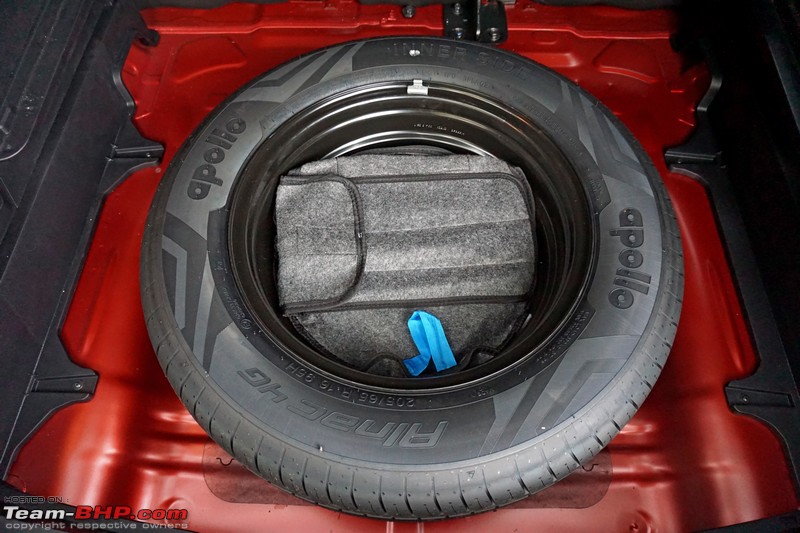 Spare wheel in all trim levels is a 16" steel unit with 205/65 section Apollo Alnac 4G rubber. In a premium product like the Creta, the higher variants should have gotten a spare of the same size as the regular wheels. When using a thinner space saver, remember to drive very cautiously (due to the varying tyre sizes and grip levels):  Toolkit has the regular tyre changing equipment. We like their black colour (tools are usually provided in silver):  Last edited by Aditya : 17th September 2020 at 10:46. |
| |  (31)
Thanks (31)
Thanks
 |
| The following 31 BHPians Thank ChiragM for this useful post: | akshay81, Amity, Arnav Vaghela, ashis89, AYP, Bibendum90949, CarguyNish, Col Mehta, daretodream, dark.knight, GTB, GTO, guyfrmblr, InControl, jailbird_fynix, lemedico, Leoshashi, lovetorque, MSAneesh, Nazaar25, noopster, Puffdamgcdragon, RavenAvi, regenitin, Reinhard, Researcher, S.MJet, Simhi, vb-saan, Venkatesh, Vik0728 |
| | #6 |
| Senior - BHPian Join Date: Apr 2018 Location: Bangalore
Posts: 1,565
Thanked: 17,813 Times
| In-Car Entertainment The higher variants of the Creta get a 10.25" HD touchscreen head-unit with a Bose sound system + 8 speakers (including 2 tweeters and a subwoofer). Sound quality is overall 'very good' and owners will be happy; however, it is not 'exceptional' as you would expect after seeing the Bose badges. Bass-heavy songs sound really punchy, but the MG Hector's system sounds better to our ears. Still, this one is good too and it's very important for you to set the equalizer up to your preferences. It has the usual connectivity options, including video playback via USB. The system is also connected and has "Blue Link" with more than 50 features. Connectivity via the embedded SIM card is free for 3 years. The touchscreen is superb, with no lag and its visibility is good even under direct sunlight. It is very responsive and great to use. Screen resolution and clarity are impressive. Good to see that physical buttons have been provided as well for those who prefer using them over a touch interface (these are better to use on the move). It even gets a rotary volume knob, which the Seltos does not:  8 speaker system includes one on top of the dashboard…  ...and a subwoofer in the boot:  The amplifier is located under the front passenger's seat:  You can have a split screen with lots of concurrent displays (map, media / Android Auto, compass etc.). Because of the large display, this is one of the rare cars in which you can see the Android Auto screen as well as the car's regular display together. In most cars, Android Auto takes over the entire screen. This can too if you click on the option which...  ...shows this screen for Android Auto. The system supports Apple CarPlay too:  Love these small touches! You can choose the options for the steering's mode button:  Interestingly, the volume of the parking sensors can be set:  The auto-locking and unlocking functions of the doors can be enabled or disabled. It’s a great relief that auto-unlocking can be turned off! It's not an apt feature for crime-laden India:  The system tells you when the service is due, in terms of days and kilometers:  We love the 'driver approach' feature, whereby the ORVMs fold out as you walk to your Creta:  The climate control will switch to "fresh air" mode automatically if it has been in the recirculation mode for a certain period of time. This is quite important as driving for long durations in 'recirculation mode' can make you drowsy - more information. When the washer fluid is used, outside air is not let into the cabin to prevent the washer fluid scent from entering the cabin:  The air purifier's fan speed can be adjusted from here. The rear display can be turned on / off. One can even check when the filter of the air purifier needs cleaning:  The system has an in-built memory of 128 MB! 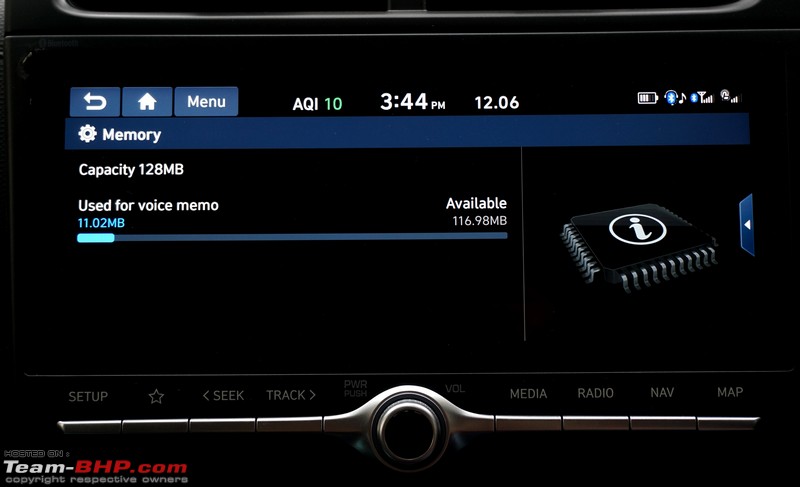 One can access the manual of the infotainment system by scanning the QR code:  The Creta comes with "Blue Link" telematics with more than 50 features for safety and security, remote operations, convenience and vehicle management. Blue Link services will be complimentary for the first 3 years, post which owners can renew them for a fee:  By pressing the rightmost button on the IRVM, you can start the Blue Link system (it's also there in the ICE). Among other things, the Hyundai call center can assist you on the destination route:  If your car suffers a breakdown, pressing the middle button on the IRVM (with the towing van icon) notifies the Blue Link connect center, which will get in touch with you and dispatch assistance to help you out. Nifty for breakdown, accident, tyre / key / battery / fuel trouble:  Emergency assistance has been provided as well. Most useful for accidents. On pressing the SOS button on the IRVM, the Blue Link connect center will inform emergency services to send assistance (police / ambulance) to your location:  The car and your smartphone will be connected to each other through a cloud-based network. You need to download the smartphone app (available for iOS and Android, both) and set up the system after which you can access a bunch of features. AT / DCT and MT models in the top-end SX or SX(O) variants come with a remote engine start feature. The car can be remotely started ONLY if the doors, bonnet and boot are properly locked and the gear shifter is in the "P" position. Note in the last screenshot how the Creta is represented by the silhouette of an Elantra:  You can set alerts and check the air quality index as well. The system also sends notifications to the phone:  Touchscreen doubles up as a display for the rearview camera and features adaptive guidelines which indicate the path that the car is going to take (based on steering input). The camera display quality is good and you can even adjust the brightness and contrast. The right half of the screen has the parking sensor display. Disappointing that Hyundai has not given the Creta a 360-degree camera (the Seltos gets it):  Camera quality at night is good:  Shift the gear lever from 'R' to any other position and the rear camera view is still displayed. It is switched off when the car crosses 10 km/h. You can also keep the rear camera permanently on while driving. Some people like Blackwasp love this feature:  Owners can download the Hyundai iBlue Remote App on their smartphones, connect it to the infotainment system via Bluetooth and use their phones as a remote control. You can select the music source, adjust the volume, equalizer and more. Might be useful for chauffeured owners, or if your kids on the backseat are controlling the music:  Connected car features can be accessed via a Smartwatch App:  Last edited by Aditya : 17th September 2020 at 10:47. |
| |  (35)
Thanks (35)
Thanks
 |
| The following 35 BHPians Thank ChiragM for this useful post: | abhinavinc, Akshay6988, akshay81, Amity, Arnav Vaghela, ashis89, Bibendum90949, CarguyNish, CEF_Beasts, Col Mehta, daretodream, GTB, GTO, guyfrmblr, InControl, jailbird_fynix, lemedico, mh09ad5578, MMV, MSAneesh, Nazaar25, na_agrawal, noopster, pms, Prakritij, RavenAvi, regenitin, Reinhard, Researcher, S.MJet, swiftnfurious, vattyboy, vb-saan, Venkatesh, xtremeshock |
| | #7 |
| Senior - BHPian Join Date: Apr 2018 Location: Bangalore
Posts: 1,565
Thanked: 17,813 Times
| Driving the 1.4L Petrol AT 1.4L turbo-petrol is an easy fit in the bay:  The Creta is powered by a 1.4L, 4-cylinder turbocharged Kappa petrol engine. It features a direct-injection fueling system and complies with BS6 emission norms. Mated to a 7-speed DCT, this engine produces a strong 138 BHP (@ 6,000 rpm) and 242 Nm (1,500 - 3,200 rpm). The power figure is the same as that of the Kia Seltos which puts it comfortably ahead of all its other rivals in the C2 segment. Because it's a direct-injection turbo-petrol, you can expect long-term maintenance costs to be a little higher than the naturally-aspirated engines. The petrol DCT weighs 1,323 kg giving it a power-to-weight ratio of 104 BHP / ton and a torque-to-weight ratio of 183 Nm / ton. Hyundai is offering only a dry clutch 7-speed DCT on the Creta 1.4L turbo-petrol. The DCT is available only in the SX and SX(O) trim levels. Both are equipped with hill-hold, ESP, multi-drive modes and selectable terrain modes. A dual-clutch transmission uses two clutches, which are controlled by electronics and hydraulics. The clutches operate independently, with one clutch controlling the odd gears (1st, 3rd, 5th & 7th), while the other controls the even gears (2nd, 4th & 6th). This allows gears to be changed instantly, without interrupting the power flow from the engine to the transmission. Dual-clutch technology offers lightning-fast upshifts, although the downshifts are not as fast. Reliability has always been a weak point of this technology (TAKE THAT extended warranty!). Dual-clutch gearboxes from Volkswagen and Ford have suffered from serious reliability issues in India. We will keep our fingers crossed on the durability of Hyundai-Kia’s DCT. The Creta DCT has 7 gear ratios, which results in a superior spread of gearing. The transmission has “S” and manual modes, and it also gets paddle shifters, which are missing in the Seltos. The DCT gearbox is smooth and the entire package is very refined. With your foot on the brake pedal, hit the engine start button to fire up the engine. The Creta DCT is exceptionally refined at idle. It moves off seamlessly from a standstill, with minimal lag. Light accelerator input is all you'll need to commute in the city. The gearbox moves up early, while shifts are quick and super smooth. Driving in a regular style, you'll never even know that the gears are being changed. Due to the refinement of the engine, there's no sound of the engine tone changing either. The turbo-petrol is very fast and with 138 BHP + 242 Nm on tap, the gearbox's job is made easier. The DCT is almost never found hunting for gears. The combination of this engine, smooth gearbox, light steering, excellent ergonomics, properly placed dead pedal and good frontal visibility made the Creta a breeze to drive in Bombay. It can crawl in bumper to bumper traffic conditions at 6 - 7 km/h after you lift your foot off the brake pedal in 'D'. This way, you can drive in heavy traffic with just the brake pedal. Be warned though, the practice has a downside and you shouldn't do it for an extended duration. The DCT starts heating up. An easy way out of this is to just use the auto-hold function (which the Seltos doesn’t get). It is a boon in traffic as you don’t have to continuously keep the B-pedal pressed while waiting and it also eases the stress on your transmission. In the worst situation, if you get the transmission overheating warning, just pull over and let the gearbox cool down. Sad that the Creta's MID doesn’t have a gearbox temperature gauge (Seltos gets it) which would help avoid this in the first place. The powerful turbo-petrol gives the Creta AT very long legs. It is punchy and fast on the expressway and will keep petrol-heads happy. Floor the accelerator and you'll see a bit of torque steer too, with the car accelerating to 100 km/h in just under 10 seconds. The mid-range is strong as is typical of turbo engines; this is very helpful during overtaking. On the expressway, at 100 km/h, the engine spins at a relaxed ~1,800 rpm and ~2,250 rpm at 120 km/h. We found the kickdown response time to be satisfactory. The transmission and turbo are quick to respond and the reaction times are short enough. Pushed hard, the engine will revv to just ~6,250 rpm before the transmission shifts up. We found the rev limit to be low for a petrol engine. There is also an “S” mode which makes the transmission more aggressive. This mode can be engaged by moving the gear shifter to the right. Use it when you're in the mood for fun, or just temporarily to quickly overtake someone. You can use the manual shifting arrangement by pulling the paddle shifters (left to downshift and right to upshift). The shifts are positive and enthusiasts will like using them. We noticed that the transmission does not shift to 7th gear with "S" mode engaged. The Creta has exceptional refinement & NVH levels and the engine is barely audible at slow speeds while driving around town. It is only at higher revvs that you can hear the engine. There’s minimal-to-zero sound heard in the cabin if you're driving calmly. Even while cruising on the highway, the engine is quiet enough. The engine sounds alright at high rpm, but not sweet as say, the Honda 1.5L Vtec. Above 5,500 rpm, it starts to get boomy. All said and done, as competent as this engine and gearbox combination is, Volkswagen's DSG is a notch above Hyundai-Kia's DCT IMHO. It remains the best dual-clutch gearbox we've experienced. In terms of FE, the ARAI-certified fuel economy figure of the Creta Petrol DCT is 16.8 km/l. The Creta DCT gets selectable driving modes: Eco Mode - Engage 'Eco' mode to take the engine into its most fuel-efficient mode. Frankly, because of the powerful engine, this mode is also very usable. It's not dull or dead at all, like in some other cars. With a light steering, muted throttle response and an upshift-happy gearbox, Eco is the smoothest of all to use. We drove the car in Eco mode for 100 km and had no complaints at all. Yes, the response time of the engine and gearbox is slower, but it's still practical and driveable. On the open road, this mode can be used while cruising on the expressway. Sport Mode - Engaging Sport makes the car noticeably more responsive to throttle inputs. The difference is immediately felt! Here, the transmission holds gears for longer and doesn’t shift up quickly. It also gives you the best steering weight for highway driving. Enthusiasts will love this mode and use it whenever they're in the mood for some fun. On the flip side, we found Sport to be too sharp for city traffic...it can make things jerky at times. The other modes are noticeably smoother. Lastly, we noticed that the transmission does not shift to the 7th cog (it remains in 6th). The Hyundai Creta DCT comes with 3 terrain modes - Snow, Mud and Sand. These modes can only be activated at speeds up to 80 km/h. Honestly, we find them useless - related discussion. 1,353cc turbo-petrol engine develops 138 BHP and 242 Nm:  Both - the petrol and diesel - get an insulation sheet under the bonnet:  A good deal of underbody protection has been provided. All the critical components appear to be well protected:  Turbocharger sits behind the engine, just ahead of the firewall:  Firewall insulation is sufficient and overall engine refinement and NVH are exceptional:  Vertically-stacked intercooler is on the left side of the engine bay:  Stylish and premium-looking gear lever is a mix of black and silver, with nice red stitching:  Unlock button is located behind it:  To engage manual mode, move the lever to the right, push forward to upshift and vice versa (just the way we prefer it!):  Glossy black rotary knob with a silver border to switch between the multi-drive modes (Normal, Eco, Sport) and terrain modes (Snow, Mud, Sand):  Even in full auto "D" mode, the display always tells you what gear is currently engaged (D1, D2 etc). As enthusiasts who pay a lot of attention to such things, we appreciated this. Use the paddle shifters and only the gear selected is displayed:  The instrument cluster turns green when 'Eco' mode is selected:  Only the numbers around the speed at which you are travelling are displayed:  The instrument cluster turns red when 'Sport' mode is selected. Also, the numbers are bigger and italicized:  Driving / terrain mode displayed on the MID:  The selected terrain mode is projected in the instrument cluster:  The 'Auto-Hold' indicator on the MID. It turns green when engaged:  The 1.4L turbo-petrol gets 'DCT' badging on the right fender...  ...and 'Turbo' badging at the rear:  Last edited by Aditya : 17th September 2020 at 10:49. |
| |  (28)
Thanks (28)
Thanks
 |
| The following 28 BHPians Thank ChiragM for this useful post: | Akshay6988, akshay81, Arnav Vaghela, ashis89, Bibendum90949, CarguyNish, CEF_Beasts, D'Ro@dSt@r, daretodream, GTB, GTO, guyfrmblr, Hayek, InControl, jailbird_fynix, lovetorque, mh09ad5578, MSAneesh, Nazaar25, Prakritij, Puffdamgcdragon, RavenAvi, regenitin, Reinhard, Researcher, S.MJet, timuseravan, vb-saan |
| | #8 |
| Senior - BHPian Join Date: Apr 2018 Location: Bangalore
Posts: 1,565
Thanked: 17,813 Times
| Driving the 1.5L Diesel MT 1.5L, 4-cylinder CRDi diesel fills the engine bay fairly well:  The Creta diesel draws power from a 1.5L, 4-cylinder CRDi engine with a variable turbocharger. The motor produces 113 BHP (@ 4,000 rpm) and 250 Nm (@ 1,500 - 2,750 rpm). This makes it less powerful than the old Creta 1.6L CRDi (126 BHP & 260 Nm). We obviously prefer that 1.6L engine. Hyundai has brought in the 1.5L to qualify for the lower excise duty slab. That said, as far as 1.5L diesels go, this is as good as it gets and the outright performance of the new Creta diesel is enough to keep most drivers happy. The diesel MT weighs 1,344 kg giving it a power-to-weight ratio of 84 BHP / ton and a torque-to-weight ratio of 186 Nm / ton. The 1.5L diesel’s refinement levels are spectacular. There are hardly any vibrations felt on startup, but there is a hint of body shake. The engine idles smoothly and even on the move, it feels very refined. The diesel's driveability is fantastic! There is almost no turbo-lag and very few gearshifts are required around town. Power delivery feels quite linear and this tune is user-friendly. The Creta diesel is easy to drive in urban traffic. There is adequate torque delivery even before the turbo spools up, and the engine can pull in 2nd and 3rd gears from ~1,000 rpm without much fuss. It clears our 2nd-gear speed breaker test easily. Above 1,500 rpm, the Creta starts feeling lively and the engine comes into its powerband over 2,000 rpm. The engine is an all-rounder and feels capable on the highway. Keep the motor on the boil and it will deliver sprightly open-road performance. There is no push-into-the-seat feeling though, as power is delivered linearly. The old Creta's 1.6L diesel does feel peppier and more enthusiast-oriented. Still, the new Creta is more than adequate on expressways and handles all tasks well (including overtaking or climbing ghats). The 250 Nm of torque ensures that overtaking manoeuvres are nicely executed. Even in higher gears, there are hardly any downshifts required while overtaking slower traffic on the expressway. The Creta 1.5D can comfortably maintain 3 digit speeds all day long. That additional ratio on the 6-speed box allows a superior spread of power and the gear ratios are perfectly chosen. Additionally, the 6th gear brings relaxed cruising ability. The car sees 100 km/h @ ~2,000 rpm and 120 km/h @ ~2,400 rpm. The engine has an enjoyable mid-range too. It revvs till 5,200 rpm, but as is the case with most diesels, there is no point in going so high on the gauge. Not much go available after 4,500 rpm. The diesel's 6-speed gearbox is smooth to operate with short throws and a light shift action. The gates are well-defined. Its clutch is light enough, although the pedal has a longer travel range than you'd expect in a monocoque crossover. Coming to NVH levels, this 1.5L engine is among the most refined diesels around. It never sounds rough or too loud. In fact, when cruising on the highway, it doesn't sound like a diesel at all. Things get loud only near the redline (4,500 rpm). Other than that, the engine is sweet and smooth. The ARAI-certified fuel economy of the Diesel MT is 21.4 km/l, which is higher than the Seltos 1.5 diesel's 20.8 km/l. 1,493cc diesel engine develops 113 BHP & 250 Nm:  Variable geometry turbocharger sits behind the engine, just ahead of the firewall:  Sufficient insulation is provided on the firewall. Overall refinement levels are top class:  Vertically-stacked intercooler:  Smooth and sweet 6-speed MT:  MID has a gearshift indicator. Newbies will appreciate. It shows which gear you should shift to in order to obtain the best fuel economy:  A red "R" is displayed when reverse gear is engaged:  The diesel manual gets auto-hold function. Could be helpful for newbies when setting off from an incline. The system cannot be engaged with the doors open:  Last edited by Aditya : 17th September 2020 at 10:50. |
| |  (39)
Thanks (39)
Thanks
 |
| The following 39 BHPians Thank ChiragM for this useful post: | akshay81, amit_purohit20, Arnav Vaghela, ashis89, ashvek3141, AYP, Batfreak, Bibendum90949, CarguyNish, CEF_Beasts, D'Ro@dSt@r, GTB, GTO, guyfrmblr, haisaikat, harry10, iamitp, InControl, jailbird_fynix, lovetorque, mh09ad5578, MSAneesh, Nazaar25, noopster, PraNeel, Puffdamgcdragon, RavenAvi, regenitin, Reinhard, Researcher, RohaNN_kWh, S.MJet, samaspire, sparky@home, swiftnfurious, vattyboy, vb-saan, Venkatesh, Vik0728 |
| | #9 |
| Senior - BHPian Join Date: Apr 2018 Location: Bangalore
Posts: 1,565
Thanked: 17,813 Times
| Ride & Handling The Creta sports a McPherson strut suspension with coil springs at the front and a coupled torsion beam at the rear, which is the same setup as the Seltos. However, the tuning is what differentiates these cars. Right off the bat, you will notice that the Creta rides noticeably better than the Seltos. You could say that ride comfort is between the old Creta and new Seltos. While the 1st-gen Creta was the most comfortable of the group, the Seltos is too stiff for Indian roads. This new Creta's ride quality is more liveable than the Kia. Nevertheless, it does have an underlying firmness to it. Bad roads are felt inside the cabin, but not as much as in the Seltos. You get 17" rims with 215/60 section tyres on the top two variants, and 16" rims with 205/65 tyres on the other variants. The ride quality on the smaller rims is likely to be more comfortable. To improve it on the 17 inchers, we have a solution for you - drop the tyre pressure in the city to 31 PSI for a cushier ride, but make sure you bring it up to the recommended 33 PSI for your highway trips. Talking about highway trips, the upside of this suspension setup is that the Creta behaves nicely at high speed. There is no bounciness or that feeling of floatiness like in the previous generation car. The new Creta feels very planted and composed at speed. Believe it or not, this is a rare Hyundai that is actually fun on the highway! Hyundai has come a long way in terms of handling, and there is no nervousness at high speeds. Recovery from expressway undulations is also good for a Korean car. In fact, the high speed behaviour pleasantly surprised us. Stability & grip levels are both impressive. Of course, due to its height, some body-roll is present, but it is well-controlled and one can push the car through the corners confidently. It is good to know that the SX and SX(O) variants are equipped with Electronic Stability Control (ESC) + Vehicle Stability Management (VSM), which can be a life-saver in emergency situations. The Creta gets a well-tuned electric power steering (EPS) that is light and smooth in the city. As the speedometer climbs, the EPS feels reasonably direct and quick. At speed though, it could have been a little less sensitive to driver inputs. The Creta's turning radius is 5.3m, which is identical to the Seltos and slightly wider than the old car's 5.2m. The SX and SX(O) variants of the Creta come with disc brakes at the rear too. While braking from high speeds, the car stops in a straight line without any drama. The brakes feel far superior to the 1st-gen Creta's. Last edited by Aditya : 17th September 2020 at 10:41. |
| |  (40)
Thanks (40)
Thanks
 |
| The following 40 BHPians Thank ChiragM for this useful post: | Akshay6988, akshay81, Arnav Vaghela, ashis89, ashvek3141, autocool, Batfreak, Bibendum90949, BIL2_HGi10, CarguyNish, CEF_Beasts, daretodream, GTB, GTO, guyfrmblr, haisaikat, harry10, iamitp, InControl, jailbird_fynix, mh09ad5578, mopy95, MSAneesh, naveen.raju, Nazaar25, noopster, Osteon206, Puffdamgcdragon, RavenAvi, regenitin, Reinhard, Researcher, S.MJet, sam264_2000, swiftnfurious, UD17, vattyboy, vb-saan, Venkatesh, yogiii |
| | #10 |
| Senior - BHPian Join Date: Apr 2018 Location: Bangalore
Posts: 1,565
Thanked: 17,813 Times
| Other Points • The Creta shares the same 1.5L Diesel + 6-speed AT combination as the Kia Seltos. Click here to read our driving report of the same. The Creta also shares the same 1.5L Petrol + 6-speed MT combination as the Seltos. Thanks to BHPian rahul_goyal for giving us a comprehensive ownership report of the Seltos 1.5L Petrol MT and bluevolt for his take on the Seltos 1.5L Petrol MT. A big shoutout to RavenAvi for his ownership review of the Creta 1.5L Petrol IVT. • The 2nd-gen Creta was first unveiled in China at Auto Shanghai 2019. • The Creta was first displayed in India at the 2020 Auto Expo. Production began in March 2020 at Hyundai's plant in Sriperumbudur, Tamil Nadu. • Team-BHP first spotted the Creta petrol DCT being tested on Indian roads in December 2019. Hyundai claims that the Creta has been tested on 17 test tracks to simulate various road driving conditions. • Front passenger seat also has a seatbelt sensor. • Available in 5 variants - E, EX, S, SX, and SX(O). • Click here to see BHPian Vedant Gupta's post on a feature comparison between the Creta and Seltos. • Doors auto-lock at 15 km/h. • The Creta has a 'battery saver' feature to prevent flat batteries. If you switch off the car with the headlamps & foglamps on, the system automatically turns them off. • Black interiors are available on the turbo-petrol variants. Other cars get dual-tone Black & Greige interiors. • The 1.5L naturally aspirated petrol and the 1.5L diesel cars come with 7 colour options - Typhoon Silver, Polar White, Red Mulberry, Galaxy Blue, Lava Orange, Phantom Black, and Titan Grey. The turbo-petrol variant gets two dual-tone and one single colour option - Polar White with Phantom Black roof, Lava Orange with Phantom Black roof (our Petrol DCT test car colour), and Deep Forest. • More than 650 Gen-4 robots are involved in the manufacturing of the new Creta. They operate for 295 days in 3 shifts for 6 days a week. • Nearly 2,500 connected machines in the Hyundai factory generate 11.7 billion data points per year. The data is analysed by more than 50 data scientists. • Hyundai claims that the new Creta is manufactured with 84% renewable energy. • According to BHPian RavenAvi, Hyundai has fixed the braking issues of the first-gen Creta by getting a new vendor for the ABS. • The ICE screen switches to "night" mode, independent of the headlights. We had kept the headlamps off and drove through a very small tunnel during the day, the ICE screen smartly switched to night mode then, and back to day mode once we got out of the tunnel. • Standard warranty of 3 years / unlimited km, 4 years / 60,000 km or 5 years / 50,000 km is available. It can be extended up to 5 years / 1,40,000 km. We strongly recommend the max possible coverage available. • First service visit at 1,500 km / 2 months (just a checkup), second at 10,000 km / 12 months. Subsequent services after every 10,000 km / 12 months. • The Hyundai Creta brochure can be viewed here - Hyundai Creta.pdf. • The Blue Link brochure can be viewed here - Hyundai Blue Link.pdf. Last edited by Aditya : 22nd November 2023 at 19:11. |
| |  (28)
Thanks (28)
Thanks
 |
| The following 28 BHPians Thank ChiragM for this useful post: | Akshay6988, Arnav Vaghela, ashis89, BIL2_HGi10, CarguyNish, daretodream, GTB, GTO, Hayek, jailbird_fynix, lemedico, mh09ad5578, MSAneesh, naveen.raju, Nazaar25, noopster, PM - B, Puffdamgcdragon, RavenAvi, regenitin, Reinhard, Researcher, Simhi, swiftnfurious, UD17, vattyboy, vb-saan, yogiii |
| | #11 |
| Senior - BHPian Join Date: Apr 2018 Location: Bangalore
Posts: 1,565
Thanked: 17,813 Times
| The Smaller yet Significant Things Galaxy Blue colour of our diesel test car:  Partial plastic cladding in the front wheel well...  ...and full cladding in the rear:  McPherson strut suspension with coil springs at the front:  The rear suspension is a coupled torsion beam setup:  3 clear markings to indicate the diesel car's diet! Anything to prevent accidentally putting in the wrong fuel, we say!  Petrol doesn't get any such labelling:  50L fuel tank is on par with the Tata Harrier's and Seltos':  If the air pressure in any tyre is low, this warning comes up on the MID, showing you the problematic tyre: 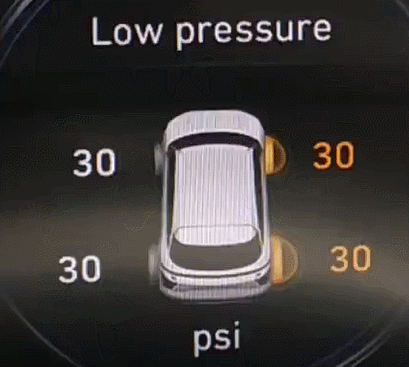 A warning appears below the tachometer as well:  Powerful LED headlamps do a good job of lighting up the road ahead:  With the high beam engaged, the throw is excellent!  ORVMs are India-friendly and will move the other way if a biker side-swipes them:  Recommended tyre pressure is 33 PSI all-round (35 PSI with a full load of passengers and luggage):  Faux leather covers up the ugly gap between the dashboard and steering console - a premium touch:  All interior buttons are backlit in white. Unfortunately, on the driver's console, the passenger window and central locking buttons aren't! We're disappointed that Hyundai missed this much-needed feature. Such cheap cost-cutting doesn't suit an otherwise premium car:  Driver’s footwell gets 2 hooks to hold the floor mat in place. Even these mats are as funky as the exterior styling!  MID asks you to lower your speed whenever you cross 80 and 120 km/h with two simple words = Reduce Speed:  A peek at the cruise-control display. The function works at speeds above 30 km/h: 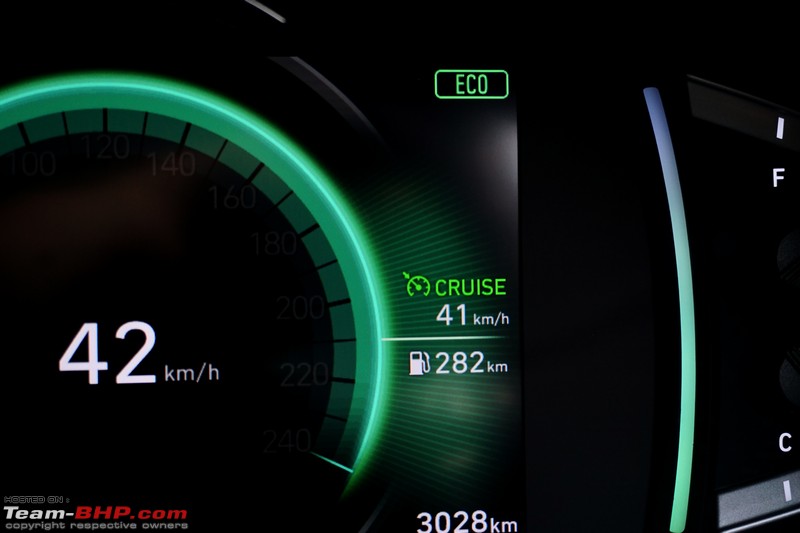 You can change the number of times the lane change indicator flashes:  VIN is lightly engraved on a beam, below the driver's seat:  Blue ambient lighting is available on the SX and SX(O) variants. There's an LED strip on the driver side of the dashboard...  ...as well as the passenger side:  Brown key looks so terribly out of place! The 2020 Creta has no brown otherwise. Hyundai needs to update this. Black key fob on the Verna (reference image) would be ideal here, but not this brown:  If the person with the keyfob has exited the car, a very prominent audible warning is sounded. A warning comes up in the MID as well:  Drive with the door open and the MID shows the door open warning with a red circle around it:  A look at the puddle lamps below the ORVMs at night:  A look at the detailing on the door panels. The same is present on the dashboard as well:  Lovely premium wind-tone horn sounds good:  Last edited by Aditya : 17th September 2020 at 10:40. |
| |  (72)
Thanks (72)
Thanks
 |
| The following 72 BHPians Thank ChiragM for this useful post: | abhinavinc, advenk999, aeroamit, AMG1, AmitRavi07, Arnav Vaghela, ashis89, ashking101, ashtrix, ashvek3141, AYP, AZT, bhavukjain, Bibendum90949, CarguyNish, catchjyoti, CEF_Beasts, Col Mehta, Cyborg, D'Ro@dSt@r, deadlifts26, DHARM, DieselAnna, GTB, GTO, guyfrmblr, Hayek, Hells_Fury, InControl, jailbird_fynix, jithin23, lemedico, mh09ad5578, MSAneesh, Nature&Me, naveen.raju, Nazaar25, noopster, northstar*, omranga98, Osteon206, Paavan Shetty, PapaKiloSierra9, Phukan23, PM - B, Prakritij, PraNeel, PrasunBannerjee, Puffdamgcdragon, RavenAvi, regenitin, Reinhard, Researcher, RohaNN_kWh, RWD, S.MJet, sainyamk95, sai_ace, saurabh89, Shreyans_Jain, Simhi, Spaced Out, swiftnfurious, Tucker48, UD17, Ultim8, valapad, vattyboy, vb-saan, Venkatesh, xtremeshock, yogiii |
| |
| | #12 |
| Team-BHP Support  | Re: Hyundai Creta : Official Review Thread moved out from the Assembly Line. Thanks for sharing! |
| |  (6)
Thanks (6)
Thanks
 |
| The following 6 BHPians Thank Aditya for this useful post: | GTB, GTO, Reinhard, Researcher, uday.ere, vb-saan |
| | #13 |
| Distinguished - BHPian  | Re: Hyundai Creta : Official Review A lovely 5 Star detailed review Chirag & team. Splendid photography too. As for the car - I don't like the looks. I'd pick the Harrier or the Seltos over the Creta in the looks department. At the same time - I love the cockpit of the Creta a lot more over the Seltos and Harrier. I don't like the KIA design philosophy of the dashboard. What would I give to get a Seltos on the outside & a Creta in the inside! I'm sure a lot will agree with me on this wish. As always - the little things in the cabin - finesse, finish & feel are top notch. 5 minutes in the car can seal deal for a customer. He/She will forget about the car looks on the outside. Thats how well Hyundai has done the job inside the cabin IMHO. One of those cars that truly make things feel Premium to experience rather than just on the paper. I'm sure this is what Hyundai is banking heavily on, given the otherwise polarizing exterior looks. Our market doesn't accept odd looking cars easily & takes a lot of confidence to launch the highest selling car with such a paradigm shift visually. Rather strange to see some features being given a miss when they are available on sub4m cars now. But yeah - that is I think a trade-off for cost targets. Overall looks aside, the car seems fine. Its been about a month now that a member in my housing society has got a new Creta. Its parked at a place where it is always visible to me. So far the looks have not grown on me. Reminds me of a fish always. (And he honks at least 6 times within the confines of the building when he arrives or departs, every time compulsively. Which is rather annoying now with the otherwise fantastic horn of the car.) I'm not a fan of any of Hyundai's designs post the previous version Creta (A beauty!) & Verna. (In the segments below 20 Lakh i.e.) And that continues with this Creta too. Cascade grille is just not working for me anymore. (On a lighter note - perhaps its these looks because of which they haven't given the 360 degree view camera maybe  ) )
Last edited by BlackPearl : 17th September 2020 at 13:47. Reason: Edited. Thanks. |
| |  (25)
Thanks (25)
Thanks
 |
| The following 25 BHPians Thank Reinhard for this useful post: | aarnav_b, abhijith, advenk999, ashvek3141, Bibendum90949, ChiragM, DieselAnna, GTB, GTO, Hayek, InControl, jailbird_fynix, mh09ad5578, naveen.raju, Nazaar25, noopster, NTO, rajvardhanraje, RavenAvi, Researcher, S.MJet, Simha13, The Rationalist, vb-saan, yogiii |
| | #14 | |
| Distinguished - BHPian  | Re: Hyundai Creta : Official Review So the long awaited review is out. Brilliant. A giant leap from the first gen Creta and loaded with features. Still they have missed out on the Auto wipers which I feel is more useful than auto headlamps. And I still feel the window glass is still thin as confirmed by BHPian Ravenavi (when compared to other cars). It would have made the car even more well insulated. Although I haven't driven the new Creta, I can admit that the highway manners are very good. I can feel that difference when I drive the first gen Creta and it's not confident inspiring when driving other cars from Hyundai (Grand i10, Fluidic verna v1.0). Quote:
Overall, a very good product but like I always said - Seltos exterior and Creta interior would have been a stellar combination. If I have the opportunity, I wouldn't upgrade to the new Creta (can't digest the exterior). Maybe Seltos or Harrier. Last edited by Aditya : 17th September 2020 at 19:01. Reason: As requested | |
| |  (14)
Thanks (14)
Thanks
 |
| The following 14 BHPians Thank naveen.raju for this useful post: | ashis89, ashvek3141, Bibendum90949, GTO, jailbird_fynix, jithin23, noopster, RavenAvi, Reinhard, Researcher, Sheel, The Rationalist, vb-saan, vishal.jayakuma |
| | #15 | |
| Distinguished - BHPian  | Re: Hyundai Creta : Official Review Quote:
 As RavenAvi has mentioned, on more than one occasion, my fingers have gone to power window switches thinking some window is partially open but I was wrong. IMO, the most significant update on this variant would be the suspension and the brakes. It is a pleasure to drive on the highways and the ghats due to the suppressed body roll. And you tend to brake very late due to confidence that the new brake setup gives you.  All that said, I still love the looks of the previous gen Creta, especially the refreshed variant with LED tail lamps. I found it better looking than the Seltos too. I have now seen the new Creta in all possible colors but honestly, I still can't stand its looks. Neither the front, nor the back or even the side profile. If I am forced to choose, I will opt for a black or blue shade to hide all the design elements. Last edited by ashis89 : 17th September 2020 at 12:02. | |
| |  (7)
Thanks (7)
Thanks
 |
| The following 7 BHPians Thank ashis89 for this useful post: | abhishek46, Bibendum90949, GTO, mh09ad5578, naveen.raju, RavenAvi, Researcher |
 |



